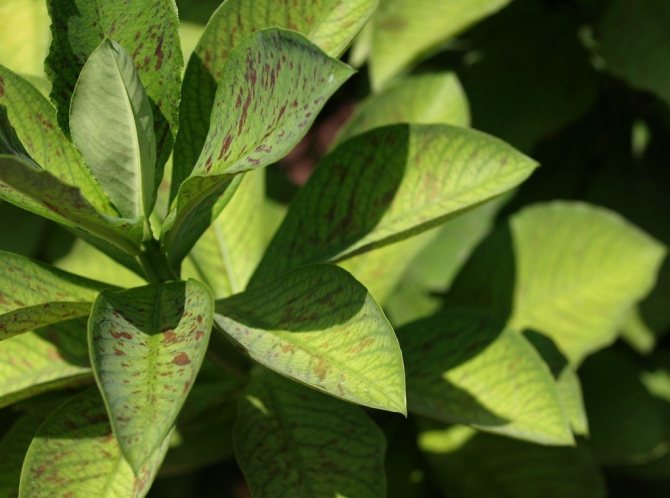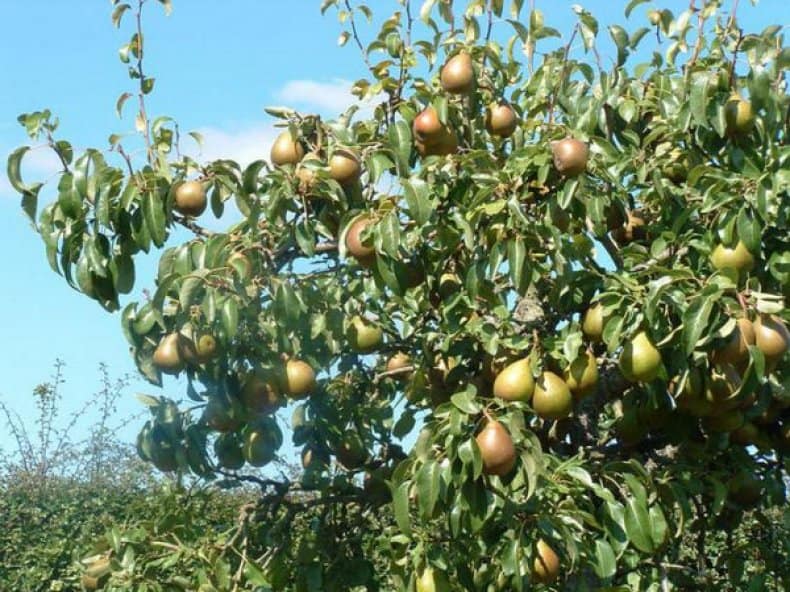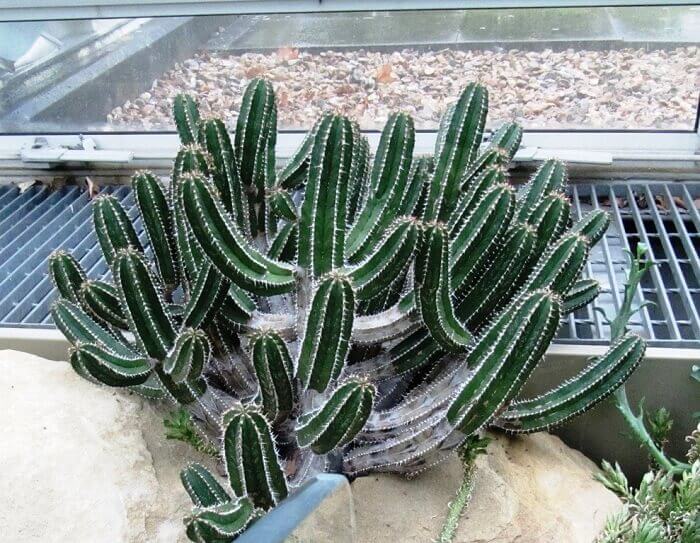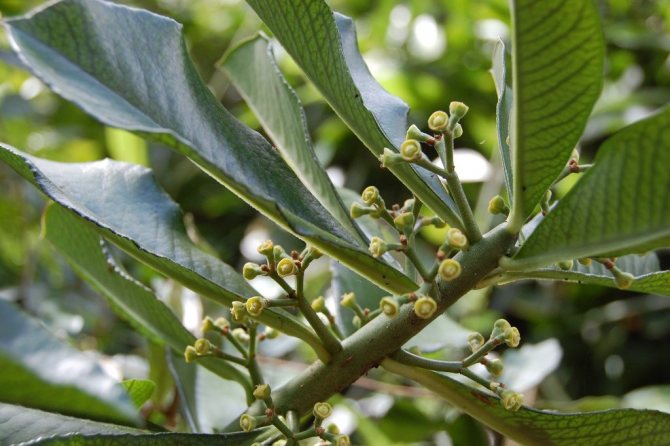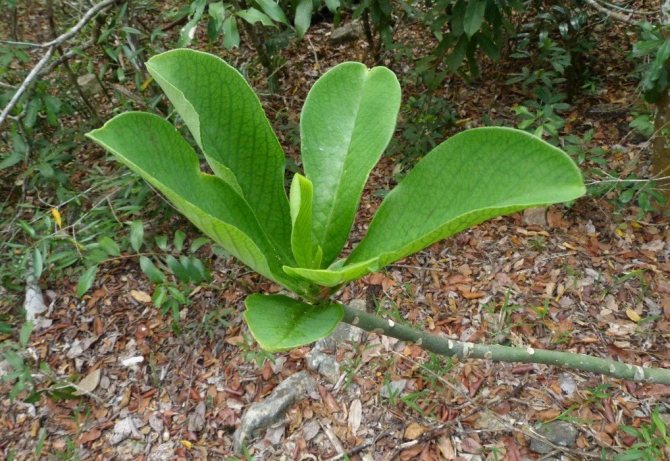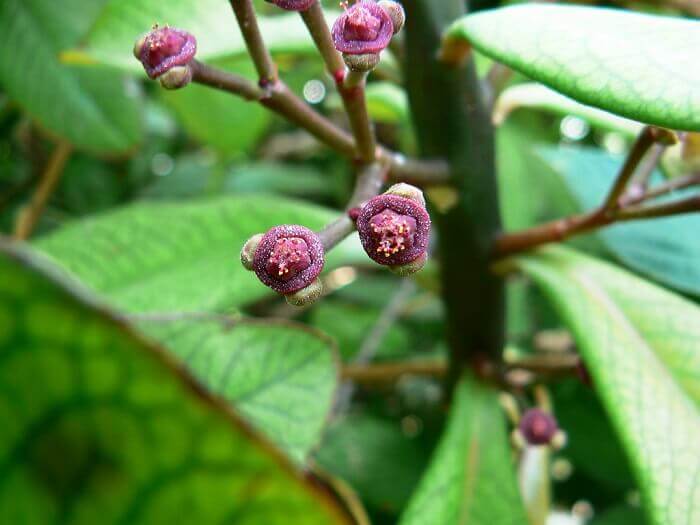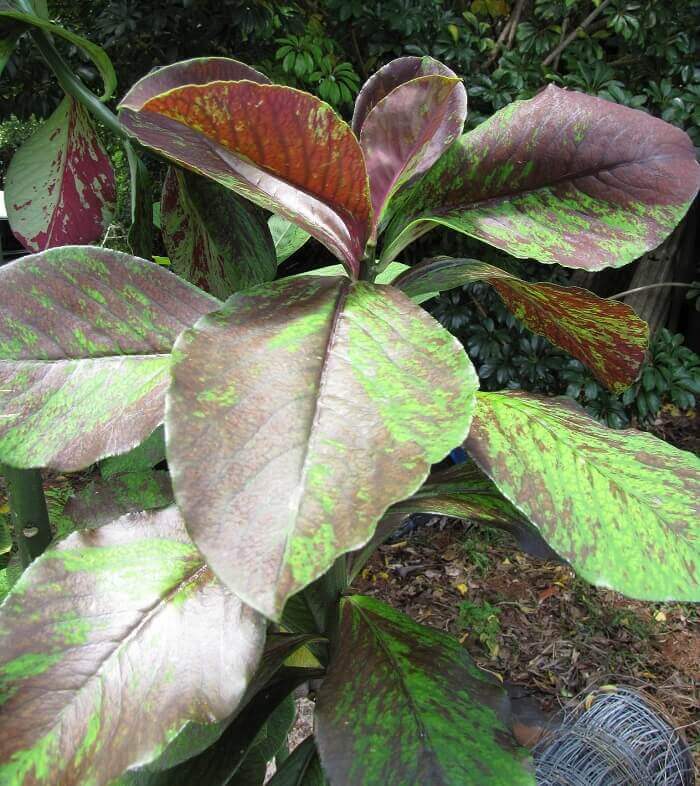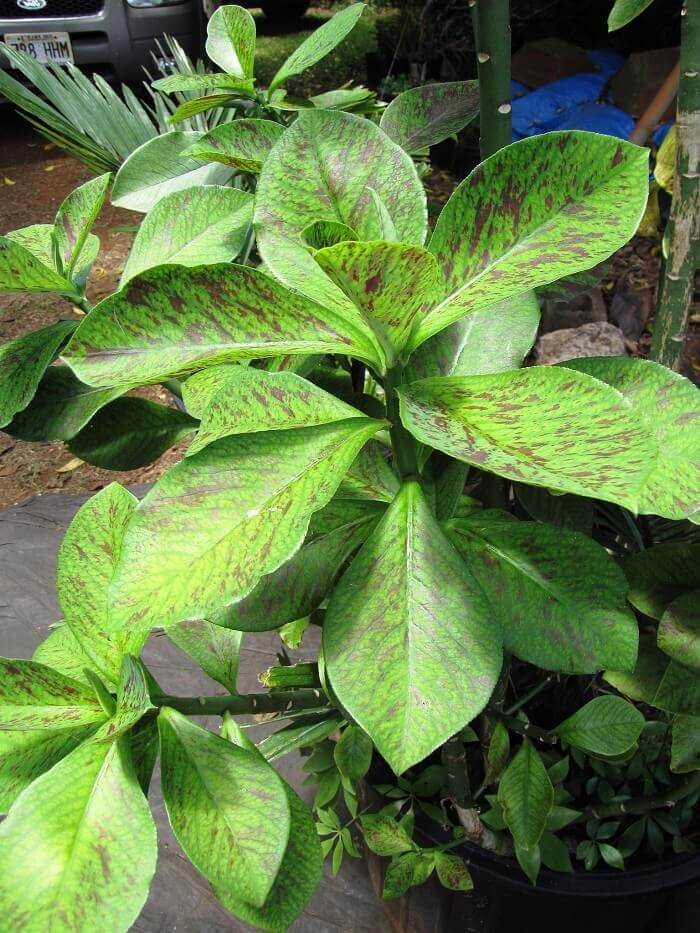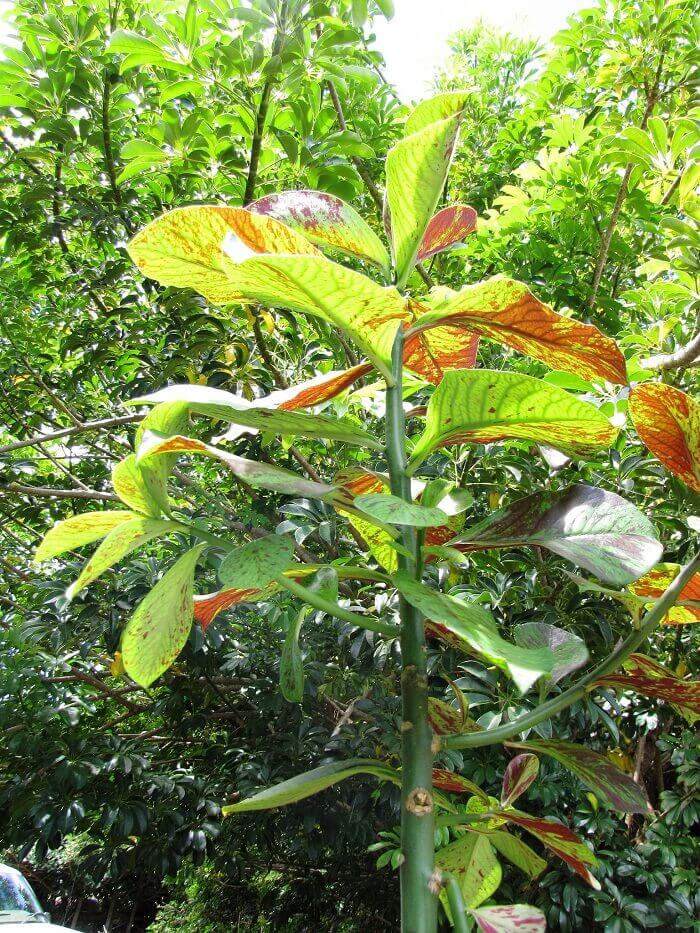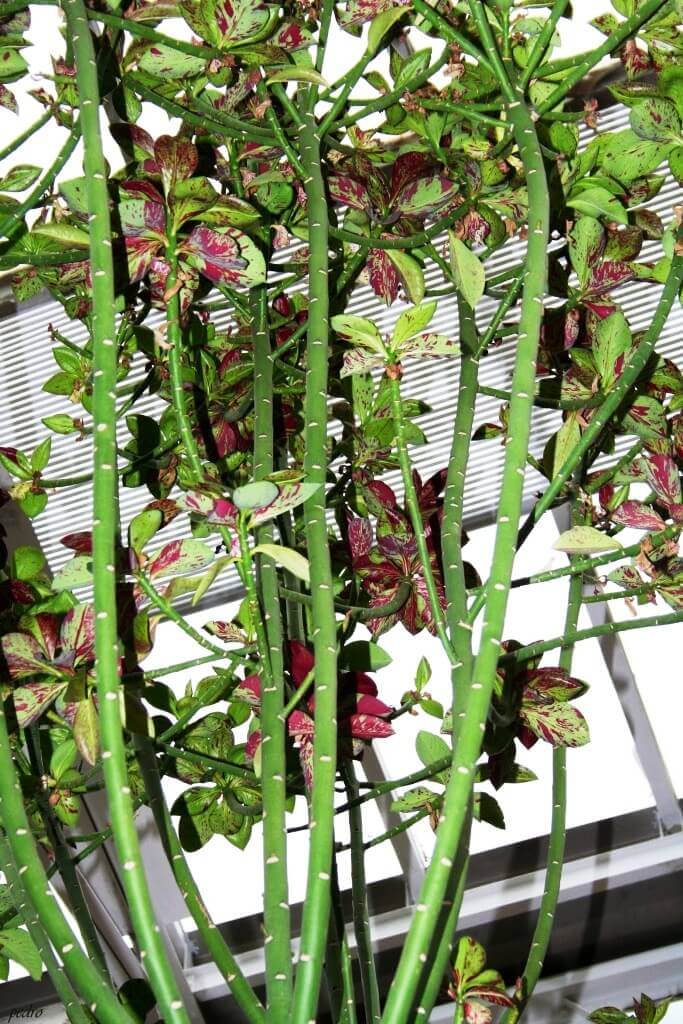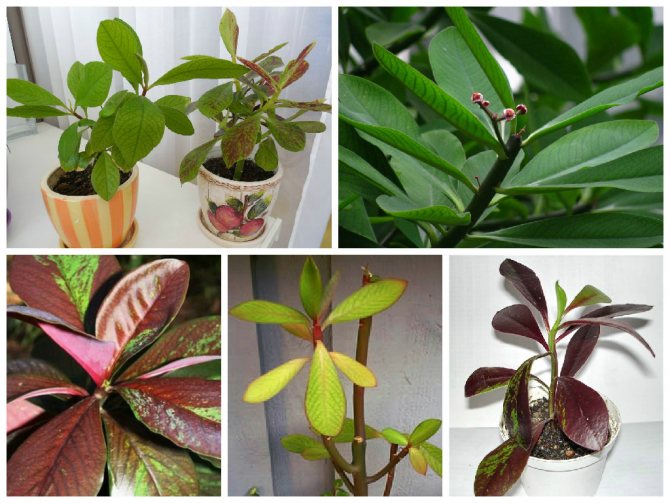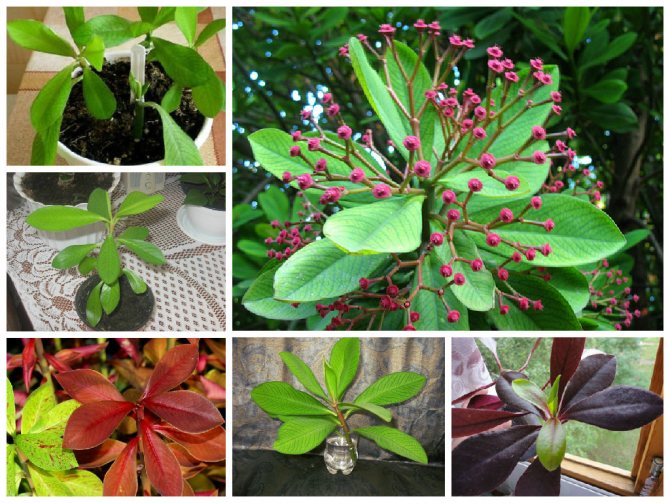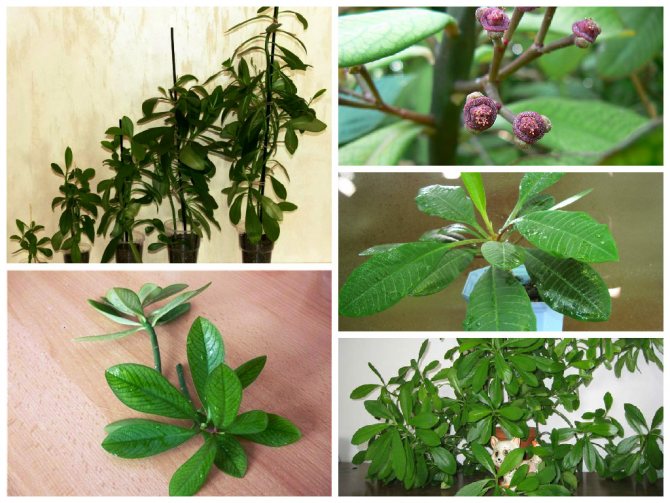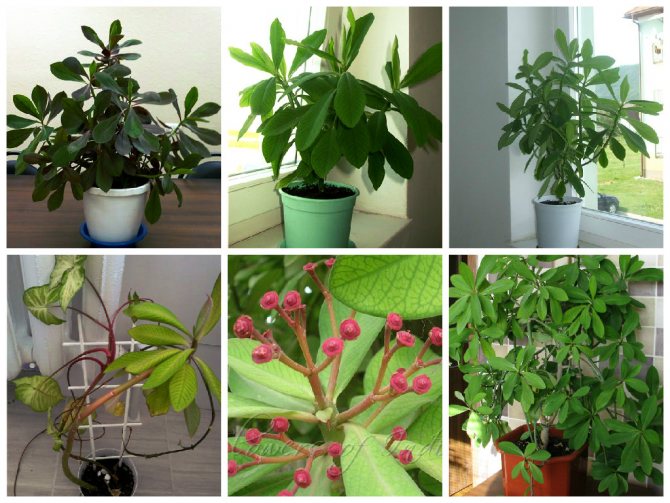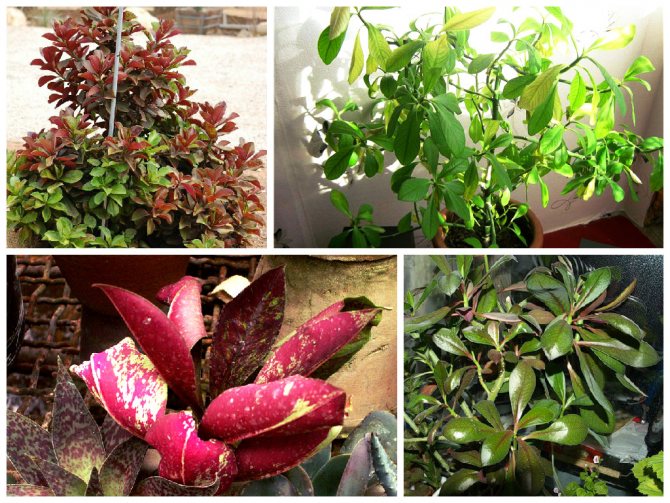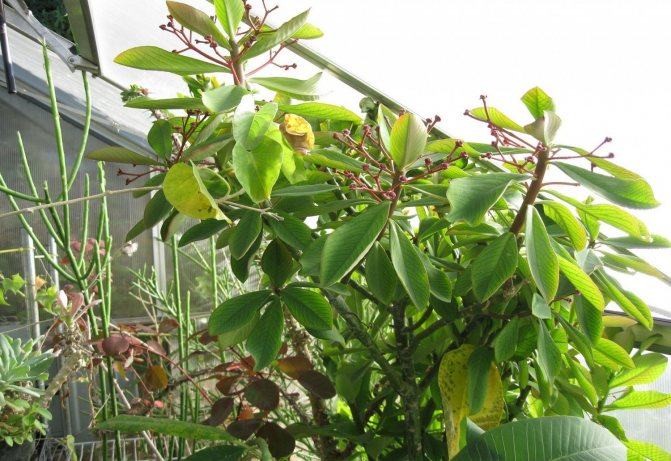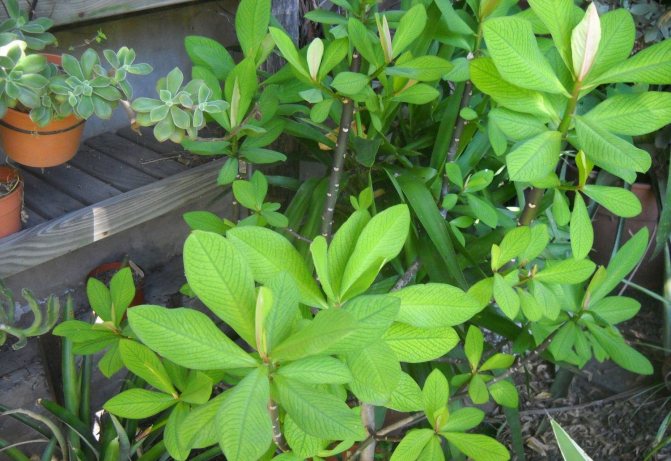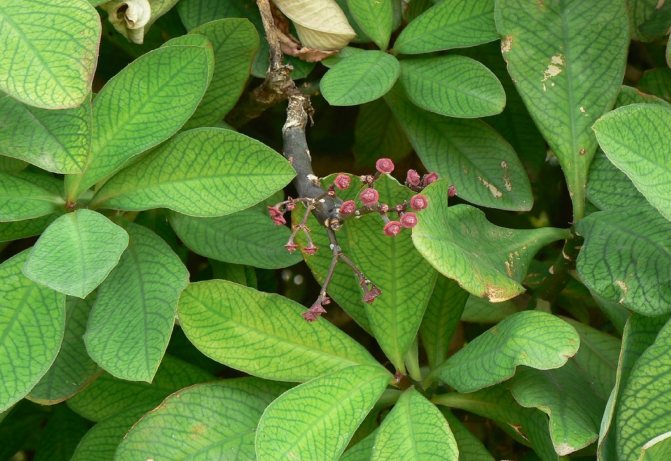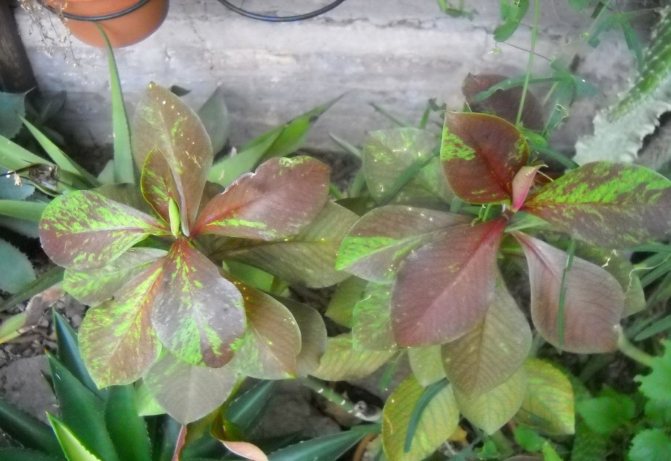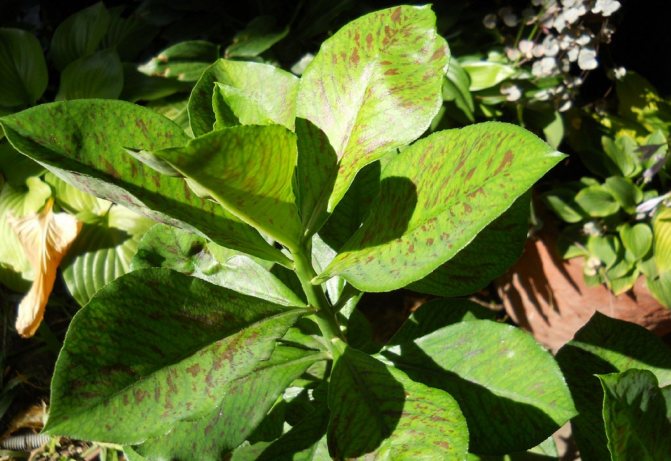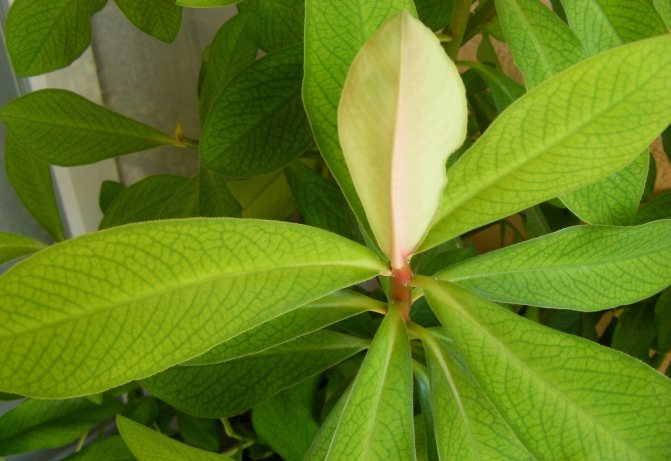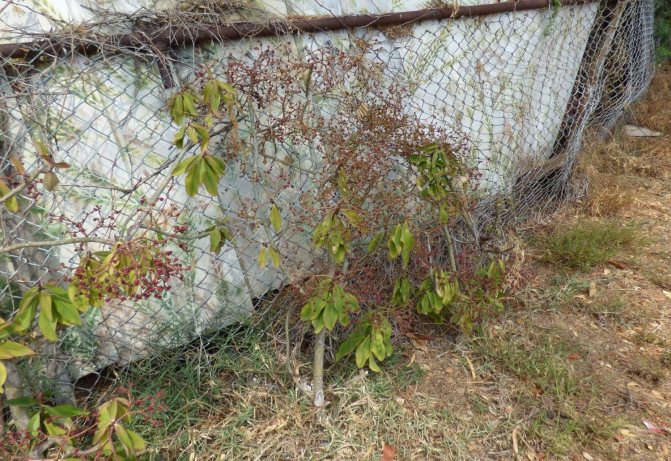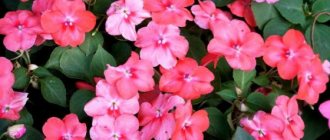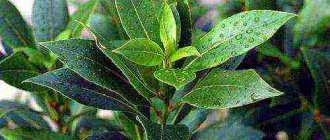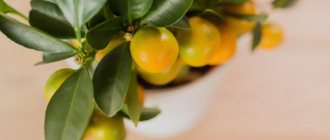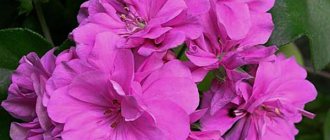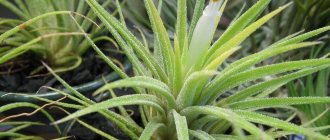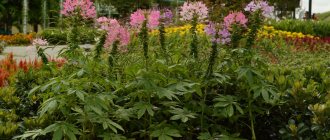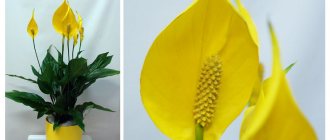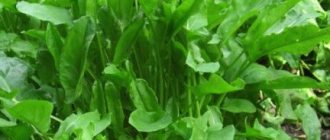Synadenium (Synadenium) is a succulent plant from the Euphorbia family. The culture is native to South Africa. In the wild, it is found in almost all regions with tropical and subtropical climates. In everyday life, it is also called the "tree of love". Synadenium got its name from the Latin words “syn” and “aden”, which means “combination” and “iron”. This is due to the presence of small glandular hairs along the stem.
In indoor floriculture, the plant is valued for its decorative leaves. Also, unlike other exotic cultures, the synadenium is rather unassuming to care for. Simple care is enough for him in the form of timely watering, fertilizing, transplants.
Sinadenium - the tree of love
It is not for nothing that Grant's synadenium flower is confused with white-throated milkweed, because it belongs to the Euphorbiaceae family and looks a little like a relative in appearance. However, it differs from it in the texture of the leaves - in the synadenium they are pubescent. The flower grows in South Africa, the genus includes about 20 varieties, but Grant's synadenium is considered the most popular. Basically, it is grown indoors. This look is suitable even for novice flower growers! Originating from the Zambezi River Valley, it is a lush shrub with branching shoots up to 3 meters high. At home, it must be "slowed down" with a forming pinch to get a miniature bush.
Sinadenium is not at all a relative of the desert adenium rose. Its name is derived from the Latin words "sin" - union, combination and "aden" - gland, which describes the characteristic feature of the plant - small hairs-glands located along the stem. The flower is a succulent, thanks to the elongated fleshy leaves and stems, it is able to store moisture for a long time. Its leaves are usually luscious green in color, but there are varieties with red, burgundy, yellow, spotted and glossy leaf plates.
The flowers of the plant are very unusual in appearance, these are umbrellas with red small stamens, they are not particularly decorative, however, they give the flower an exotic look during the flowering period. Homemade synadenium very rarely pleases with flowering, it usually happens in the summer months during the growing season. Synadenium is often called "the tree of love". There are suggestions that this flattering nickname is associated precisely with the shape of the flowers and their color.
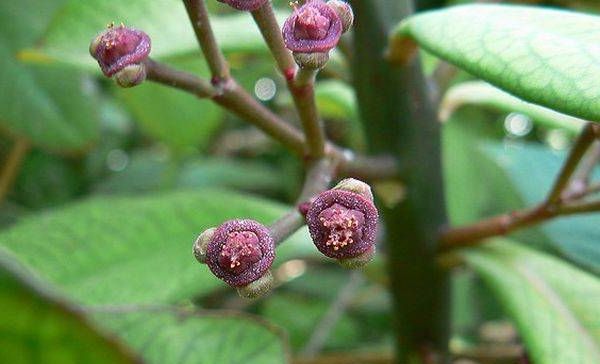
The synadenium flower belongs to toxic plants, its milky juice is poisonous, in large doses, when ingested into the esophagus, it causes poisoning, in rare cases, allergic skin reactions. Therefore, try to hide it from pets and carry out the pruning with gloves.
Synadenium in the house: benefits and harms
The milky juice contained in the plant is very poisonous. If it comes into contact with the skin, it causes irritation or an allergic reaction, and inside the body - poisoning. Therefore, you should not place the synadenium in places accessible to children.
The plant also has beneficial properties. A tincture is made from the roots of the plant, which is used for diseases of the liver, kidneys, inflammation of the bladder, and headaches. But in no case should you take funds with synadenium without a doctor's prescription.
Sinadenium, despite its African origin, is successfully grown indoors. It is appreciated by many not only for its decorative qualities, but also for its unpretentiousness. The culture can be grown even by novice florists who want to quickly and easily plant greenery in their interior.
Learn more about growing Sinadenium at home in the following video:
Care rules
Synadenium is similar to Euphorbia not only externally, the requirements for cultivation are similar to other succulents from the Euphorbia family. The site outlined the basic rules of care.
Temperature and lighting
Like most plants, synadenium loves diffused light in winter and summer. With a lack of light, it stretches out and loses its decorative effect. If the flower is kept in low light conditions in winter, it is advisable to simultaneously lower the temperature so that growth temporarily stops. What level of illumination the plants need.
In summer, the plant will be comfortable on a glazed ventilated balcony. The optimum temperature for the content is 22-26 degrees. Sinadenium Grant easily adapts to hot summer temperatures and coolness, but the critical lower limit is +10, at a lower temperature there is a risk of root death.
Watering and moisture
Being a succulent, the Grant's Sinadenium flower does not like excess moisture, overflow can provoke root decay. Therefore, in the summer it is watered after the top layer of the substrate in the pot has dried, and in the winter you can dry the soil a little more, almost half. If you are not sure if watering is necessary, it is better to postpone it! However, do not thirst the plant; excessive drought can cause leaf fall. 8 questions about watering indoor flowers.
Sinadenium is not picky about air humidity, it is not even necessary to spray it - it easily adapts to dry air in apartments in winter. What he will not refuse is a periodic shower that will wash the dust from the leaves. Do not wipe the leaves, as this can disturb the small hairs that cover the leaf plate in most varieties. Sprays and showers for plants.
Fertilizers and feeding
This flower will look much more spectacular if fed. This should be done from spring to autumn; in winter, fertilizers will be superfluous due to the forced dormant period. For feeding, universal mineral fertilizers, nitrogen fertilizers, organic fertilizers are suitable. Organics: types and methods of application. The succulent does not need frequent feeding, it is enough to carry out them once every 2 weeks, observing the dosage. What trace elements your plant lacks.
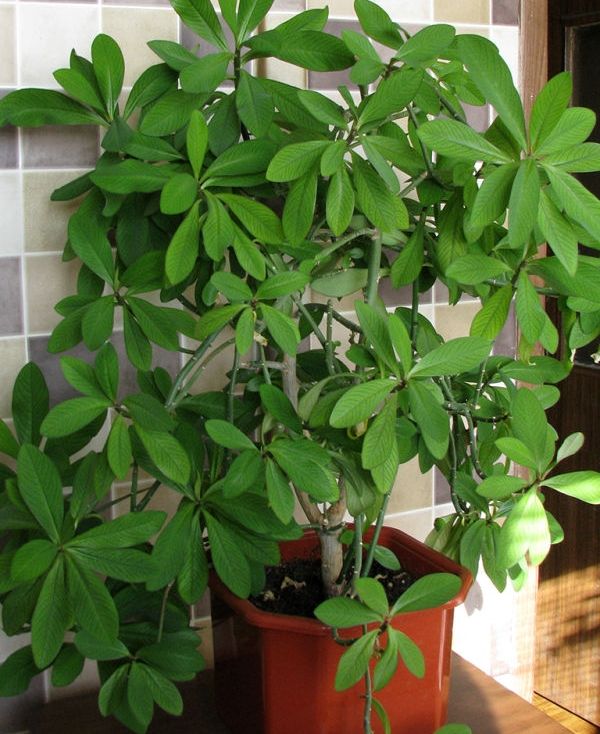

Reproduction and transplantation
The transplant of adult specimens is carried out as they grow, given that they grow quickly, then this has to be done almost annually. Sinadenium is not picky about the size and shape of the pot. It is better to do a transplant in March-April, in order to move the flower to a new soil at the same time as pruning. The root system of the plant is strong enough, so he will endure the procedure staunchly. How to choose a flower pot.
A succulent plant loves loose but nutritious soil. In this regard, soil based on compost, dark peat, garden soil is suitable. Use sand, vermiculite, fine expanded clay, or charcoal as baking powder. You can use a purchased substrate, for these purposes a universal earthen mixture is more suitable, the substrate for cacti has a too loose consistency, it cannot be taken as a basis, but can be used as a baking powder. What kind of soil is suitable for the plant.
Attention! Formative pruning. Annual "haircut" will help not only to renew the plant, but also to achieve the desired shape of the bush. It should be carried out in the spring at the beginning of the growing season, along with the transplant.If the shoots are very stretched and bare, you can use pruning: with a sharp knife, or pruning shears, cut the branches at leaf level, as shown in the photo (marked with stripes).
Be sure to treat the sections with crushed wood or activated carbon. This will stop the production of milky juice! If the bush already looks decorative, but you want to achieve more branching, do a pinch: pinch off the apical points of growth at the ends of the shoots, thereby awakening the lateral buds, but not disturbing the general appearance of the plant (marked with a circle).
Home care
Anyone can grow a synadenium at home. Nursing activities do not require much effort. More difficulties can arise from the rapid growth of the plant, which often has to be contained.
Location and lighting
The flower needs bright, diffused lighting. It is better to place it in the west or east side of the room. If he will stand on the window of the southern location, the plant needs to be protected from the direct sun. This will keep the leaves from getting burned. With a shortage of light, the shoots will begin to stretch out at the synadenium and it will lose its decorative effect.
Soil and drainage
The soil for the plant is taken light, nutritious with neutral acidity. You can buy a ready-made succulent mixture or make your own.
To prepare the soil mixture, you need to mix in equal proportions:
- leafy ground;
- peat;
- turf;
- peat.
To avoid root rot in the plant, add some charcoal to the substrate. At the bottom of the planting pot, lay a drainage layer of expanded clay or broken shards.
Planting and transplanting
Young synadeniums require an annual transplant, adults - once every 2-3 years. Since the culture is growing rapidly, in order to slow down the increase in its size, it is recommended to trim the roots when transplanting.
The procedure is carried out in March according to the following scheme:
- Prepare a larger container. Lay drainage at the bottom, sprinkle it with soil a little.
- Carefully remove the shrubs from the old pot, shake off the old soil (not all) if possible.
- Place it in a new pot. Fill the voids with soil, compact it and water it.
A warning! Sinadenium milky juice is poisonous and can cause irritation if it comes into contact with the skin. Therefore, all work with the flower is carried out in rubber gloves.
Temperature and humidity
Sinadenium loves warmth. In spring and summer, it is better to keep it at a temperature of + 23..26 ° C. The warmer it is in the room, the more light the plant needs. In winter, it is better to provide a flower with cool conditions (not lower than +10 degrees). Sudden changes in temperature and drafts lead to leaf fall.
The culture is not demanding of air humidity. It can exist normally in the dry air of city apartments. But periodically, the plant can be bathed in the shower to wash off the dust from the leaves, or wipe them with a damp piece of cloth. In extreme heat, you can spray water around the shrub so that it does not fall on the leaves.
Watering
Sinadenium grows wild in semi-arid regions. Therefore, its watering must be treated with caution. You can moisten the soil only after it dries 2-3 cm deep. After watering, drain excess liquid from the pallet.
It is important to avoid stagnation of moisture in the soil, to avoid putrefactive processes. A succulent plant tolerates drought much more easily than waterlogging of the soil. But if it is very dry, leaves may begin to fall off. In the case of a cool winter, the amount of watering is reduced.
Top dressing and fertilizers
During the growing season, the flower needs additional nutrition in order to maintain its decorative appearance. Every 2 weeks it is fed with fertilizers for cacti or deciduous ornamental crops, alternating with organic matter. They can be added only after watering, so as not to burn the roots.
Pruning
The crop grows very intensively, rapidly increasing its green mass. To contain this growth, formative pruning must be carried out systematically. This stimulates the growth of lateral shoots, making the bush more lush.
Bloom
The "tree of love" in nature blooms in winter. Peduncles emerge from the upper sinuses of the leaves, in which inflorescences with small red flowers bloom. The synadenium blooming at home is not of decorative value, but the inflorescences give it an exotic look. Home shrubs usually bloom in summer, during the growing season.
There is a version that the name "tree of love" appeared because of the shape and color of the flowers.
Growing problems?
Grant's Synadenium won't be a big deal! This is an unusually resistant plant, the care of which consists in the selection of a place and proper watering. Among the problems that flower growers may face, the following can be distinguished.
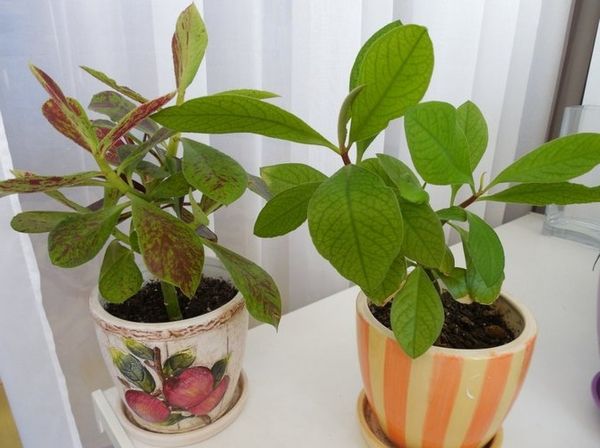

- If the synadenium sheds foliage ...
Leaf fall is usually associated with abrupt changes in conditions of detention: a drop in temperature, watering with cold water, overflow, or transplanting. This light-loving succulent recovers quickly, but if the leaf fall does not stop, it is worth examining the roots. They can easily rot from the cold or humid environment. But even in this case, the flower can be rehabilitated: cut off the bad roots, replace the substrate and normalize the conditions.
- If the leaves of the synadenium are dropping ...
Thus, the flower usually signals that it is time to water it. In case of severe drought, even shoots can lose turgor. The plant will quickly regain its shape, you just have to water it! But be careful, despite the fact that it is a succulent, prolonged drought can lead to "baldness".
- If the branches of the synadenium are strongly stretched ...
The reason for this is usually a lack of light! Like other light-loving plants (Tradescantia, Echeveria, Pereromnia, Hoya), this succulent loses its decorative effect in the shade, while internodes stretch out, the stems look "naked", the leaves thin and lose color. It is possible to restore the appearance of a flower only by pruning and constant access to diffused sunlight.
Attention! This article will help to identify the pest, and this material will tell about diseases.
Now you will also find an approach to an unusual-looking synadenium plant, caring for which is not difficult even for a beginner.
Support our site, share the link on social networks. Thank you!
Sinadenium is a lush evergreen shrub that grows in tropical African forests. He has a sprawling green crown with amazing inflorescences. The small genus includes 20 species, of which only the Granta synadenium is an indoor flower. The people also call it milkweed or the tree of love. This plant does not require complex maintenance, it has a pliable crown and an attractive appearance. It can be grown as a miniature bush on a windowsill or as a tall tree up to the ceiling.


Care errors and their elimination
The table contains useful information for flower growers about common problems when growing Sinadenium and methods for eliminating them:
| Problem | The reasons | Decision |
| Shedding leaves | A sharp decrease in temperature, watering with cold water, waterlogging | Do not overcool the synadenium, water only with warm, settled water |
| Leaves drooping and wrinkling | Moisture deficiency | Water the plant |
| Pulling the stems | Lack of lighting | Ensure constant ambient light tolerance |
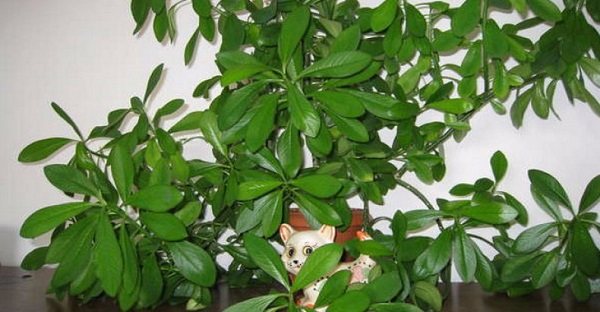

General description of the flower
Euphorbia Grant's synadenium, the care of which is quite simple, grows high (up to 3 m), spreading thickets. For a year, it grows by about 20-25 cm. It differs in branched, deep-rooted roots and succulent stems, on the branches there are rare lateral processes.They are erect and strongly thickened. The stems have a smooth dark green skin. Thanks to this structure, the plant stores moisture and is able to survive even in severe drought.
The leaves are attached to the branches with very short petioles. They are located alternately or oppositely. The leaf plate has an obovate or oval shape. The leaves themselves are quite tough, leathery, dark green in color and with a shiny surface. Some varieties have reddish streaks or spots. The leaves reach 25 cm in length and 12 cm in width.
More popular among florists, in comparison with Grant's synadenium, is Rubra's synadenium. Young leaves of this flower are completely pink, then their color changes to dark green, and reddish spots of irregular shape appear.
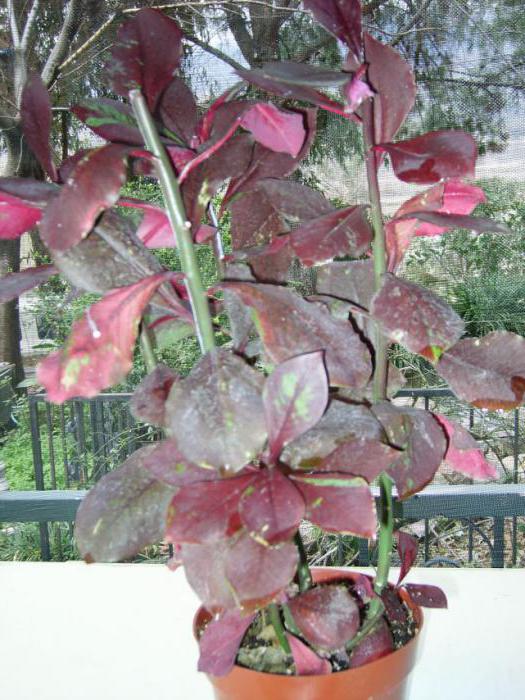

In winter, small flowers with long elastic peduncles appear on the tree of love, which collect in corymbose inflorescences. Small flowers look like tiny bowlers or bells, which have short and curved edges. In the center of each flower there are long stamens. After the flower, a small fruit remains in the form of a three-lobed achene with small black seeds.


If you break a stem or leaf, then milky juice will be released. It is very poisonous. It causes irritation on the skin, and if it is swallowed, it can be seriously poisoned, even fatal. When growing this flower at home, you need to take precautions, do not allow children and animals to visit it. When trimming Grant's synadenium, it is imperative to use protective gloves.
Bloom
In nature, the flowering period occurs during the winter months. Elongated elastic peduncles are crowned with corymbose inflorescences of small, bell-like flowers. The edges of the short petals are bent outward. In place of each flower, a fruit is formed in the form of a small box with seeds. Indoor specimens are very rare in this spectacle. In this regard, there is no exact data on any modifications and a description of the process itself with home content.
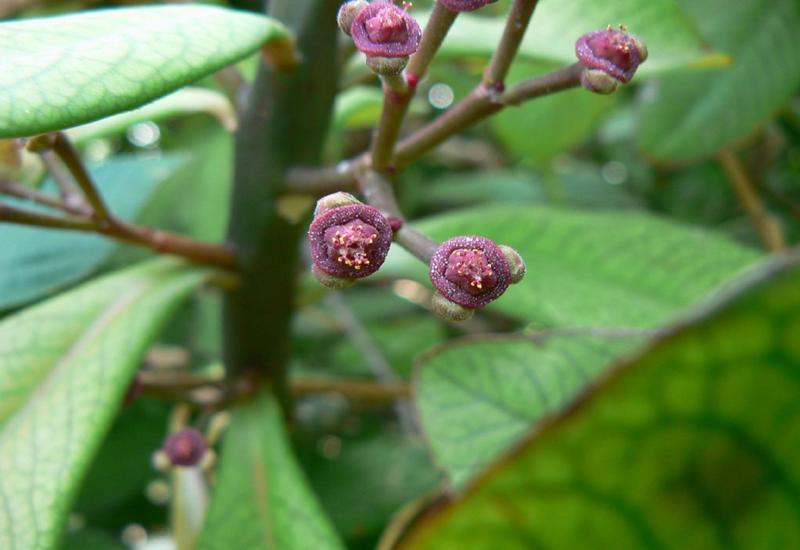

Watering and moisture
The tree of love does not tolerate excess moisture; when overflowing, the roots can rot. In the summer, it is necessary to water when the top layer of the substrate in the pot dries up, and in the winter the soil is dried even more, about half. If there is no need for watering, then it is better to wait even longer. The plant tolerates drought well, but not for long. If the soil is very dry, then after a while the leaves will begin to fall off the flower.
The humidity of the air does not really matter for the synadenium; it is absolutely not necessary to spray it. The flower adapts perfectly to the dry air of the apartment in winter. Of course, the periodic shower of the synadenium loves - it washes the dust from the leaves. There is no need to wipe the leaves - they are covered with fine hairs that can be damaged.
Succulent care
Sinadenium is considered an unpretentious indoor plant to care for.
Watering and fertilizing
The main problems are caused by a violation of the irrigation regime: the succulent does not tolerate waterlogging and instantly reacts with drooping leaves, and as a result of constant overflow, the root system rots. Therefore, it is necessary to water the plant only after the top layer of the substrate has completely dried.
However, the final drying of the soil mixture cannot be allowed when growing this particular species from the Euphorbia family, whose representatives easily lose and restore the turgor of the leaves. In contrast, synadenium lowers leaves that have lost their elasticity and no longer returns them to their previous state.
The foliage dries up and falls off, and in its place will grow another, young, but subject to all the rules of care. Often, to restore the attractive appearance of the succulent, you simply have to cut off the leafless stems to stimulate the growth of young leaves.
Overflow is also undesirable, especially in low temperature environments. The root system in a waterlogged substrate rots easily. Air humidity is not essential in growing this flower. Synadenium is fed during the growing season once every 15 days with a mineral complex for succulents and cacti. In winter, the plant rests, and feeding is stopped.
Pruning
A certain role in the decorative appearance of the succulent is played by pruning, which is indispensable when growing synadenium plants. In young specimens, the tops are pinched to stimulate the growth of lateral shoots, while older specimens are pruned at the beginning of the growing season. Mature flowers over 5 years of age will need a cardinal rejuvenating pruning with cutting off 2/3 of the length of the pagons or "on a stump", leaving 10-15 cm of the height of the main stem from the soil level.
Attention! All work with the transplantation and pruning of the synadenium must be carried out with rubber gloves in order to avoid the ingress of milky juice on the mucous membranes or skin.
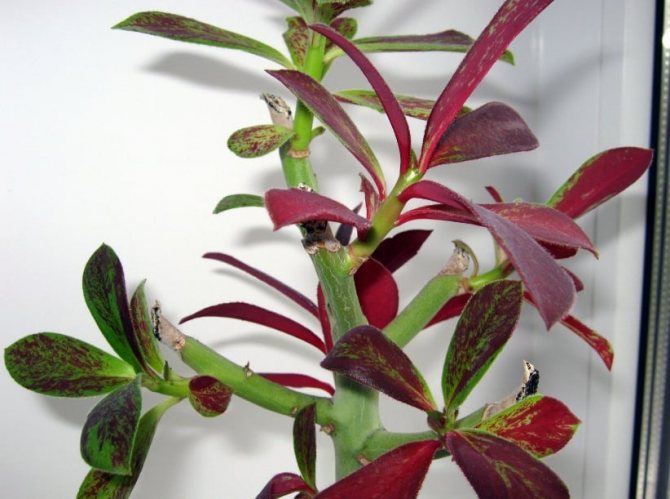

Fertilizers and feeding
Grant's synadenium flower responds well to feeding, after which the pet looks much more spectacular. It is necessary to fertilize the plant in the spring-summer period; it is better to stop feeding with the onset of winter, since the flower begins a period of rest.
You can feed with universal mineral, nitrogen fertilizers, organic matter. Often it is not necessary to fertilize, once every two weeks is enough, with the appropriate dosage.
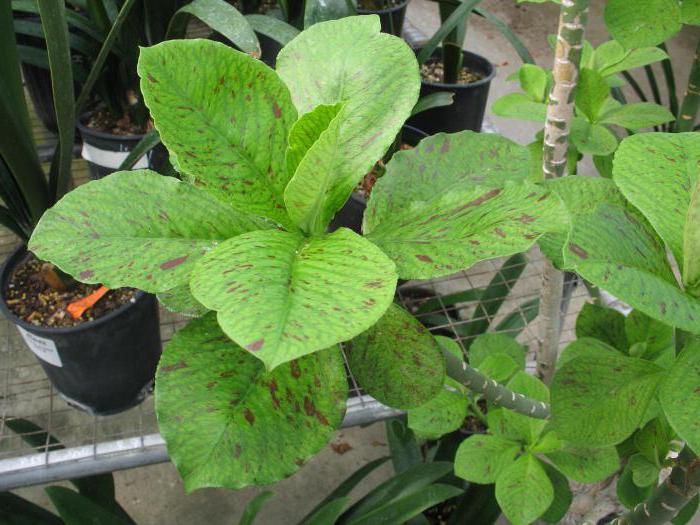

Features of seasonal care
Synadenium is actively growing in the spring and summer. He needs warmth, good lighting, moderate watering and feeding. In winter, the plant begins a period of relative dormancy. Better if it is cool. In such conditions, the amount of light is reduced, watering should become more rare. If the succulent remains to winter in a warm room, it must be provided with additional illumination with phytolamps. If this is not done, then the branches of the plant will begin to stretch out and become bare, and some of the leaves will fall off.
Plant transplant
Adult specimens are transplanted as needed. This flower grows quickly, so it has to be transplanted about once a year. The size and shape of the pot doesn't really matter. It is better to replant in spring (March-April). The flower has a fairly strong root system, so it tolerates the transplant well.
The love tree loves loose but nutritious soil. It can be based on compost, dark peat, garden soil. The baking powder can be charcoal, expanded clay or sand. The substrate can be purchased ready-made in the store - it is best to take an earthen mixture.
Correct sinandenium transplant
The plant is transplanted in the spring once a year or every other season. Young specimens need an annual transplant, adults - as the root ball grows.
Under natural conditions, the synadenium is accustomed to poor soils, but succulent develops much better in a fertile and loose substrate, consisting of sod land, humus, peat and river sand, taken in equal quantities. Purchased soil for succulents and cacti is also quite suitable. At the bottom of the flower container, a layer of expanded clay drainage is required.
They choose a plastic or clay pot for a synadenium, there is no significant difference, the plant grows well in any container. However, the irrigation regime will be different, because the soil mixture dries out more quickly in an earthen vessel.
Sinadenium is a fast growing succulent. If its owner sets the task of restraining the growth of a flower during transplantation, it means that he slightly cuts the roots and plants them in an old container, changing only the substrate. In the opposite case, a new pot is chosen with a diameter of 2-3 cm larger.
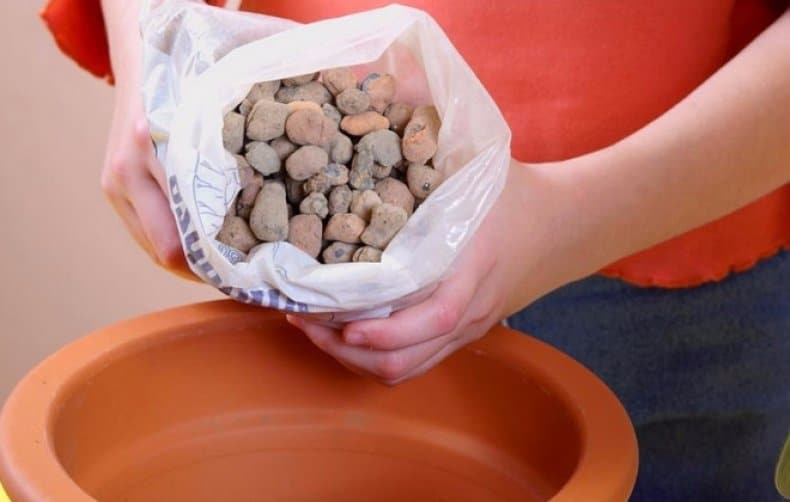

Pruning the synadenium
To maintain the beautiful appearance of the plant, it is imperative to carry out corrective procedures on time. Synadenium is no exception. How to trim it correctly is described below.
Formative pruning is done every year. The procedure allows you to renew the plant and give the bush a beautiful shape. It is carried out in the spring, before transplanting. Then the plant begins its growing season. It is imperative to prune or completely remove strongly stretched and bare branches. This is done with a sharp knife or secateurs.


All sections must be processed to stop the release of milky juice. For this, crushed charcoal or activated carbon is suitable. If the appearance of the flower suits, and there is nothing to cut, you can simply pinch off the tops of the shoots - this way the bush will branch more strongly.
To start a syngonium at home or not?
Syngonium is a beautiful indoor flower, captivating with its unusual appearance and unpretentious care. He received negative rumors about himself completely undeservedly. If you want to have this flower at home, but the signs and superstitions associated with the syngonium cause concern, we recommend that you listen to your inner feelings:
- the plant is pleasant and pleasing to the eye - feel free to take it into your collection. He will definitely not bring you unhappiness;
- if at the sight of syngonium no feelings, except anxiety, arise, it is better not to risk it. Not the fact that you will be able to make friends with him.
Reproduction of the synadenium
The love tree propagates in two ways: by seeds and by apical cuttings.
The first method is considered quite difficult. At home, synadenium rarely blooms, and you can simply not wait for seeds from it. In addition, this method is painstaking, but as a result, many plants are obtained at once. Seeds are sown in spring in sandy-peat soil to a depth of 0.5-1 cm. The pot should be covered with foil and placed in a warm, bright place.
After 10-12 days, the seeds will sprout, and when the sprouts reach a height of only 1 cm, they need to be dived into separate pots. The second pick is carried out at a seedling height of 3 cm into the soil for adult plants.
It is much easier to propagate by cuttings. When pruning, the tops of the stems remain; for planting, you need to choose long cuttings (up to 12 cm) with 4-5 healthy leaves. They need to be treated with charcoal and left to dry for 1-2 days. After this time, the cut will be covered with a whitish film, then the cutting can be planted in the soil to a depth of 2-3 cm. It will take root for 2-3 weeks.
Reproduction
You can get new representatives of the species and varieties by rooting stem cuttings and planting seeds. With caution, perform any actions associated with the release of milky juice. Keep pets and small children away from the plant. Breeds in the spring.
Stem cuttings:
- For rooting, the upper parts of the stems are cut off, a dozen (twelve) centimeters long. Be sure to have four or five healthy leaves. You can put the skulls in warm water to stop the release of milky sap, you can powder the cut with crushed charcoal or ground black pepper.
- It is advisable to dry the planting material in a shady place for one (two if necessary) days. The formation of a whitish film on the cut indicates readiness for planting. The pot is filled with earth consisting of equal proportions of peat, coarse sand and birch charcoal.
- When planting, deepening is made by two, three centimeters with a cut end into a wet filler. The seedling is placed where it is light and warm (not lower than plus twenty). After less than a month (15 to 25 days), fresh young leaves should appear. Their presence means a successful rooting result.
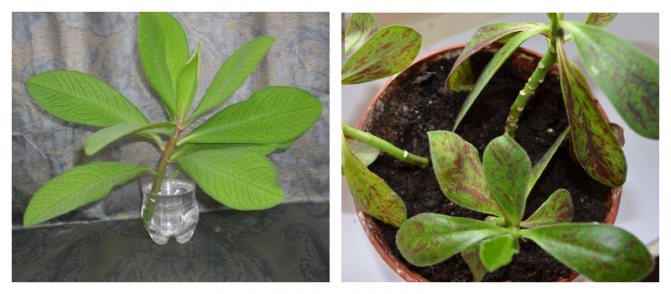

Seeds:
- A rather painstaking method of growing, however, the result is many new specimens. The prepared container is filled with a mixture of peat and sand. Seed material is sown no deeper than ten millimeters into a moistened substrate.
- A "home greenhouse" is formed: the upper part is covered with plastic wrap, exposed in a well-lit place with a constant temperature of eighteen degrees Celsius. The first shoots appear, as a rule, after one and a half or two weeks.
- Having reached one centimeter in growth, seedlings are subject to the first pick into individual vessels. Re-transplanting is carried out when young plants reach thirty millimeters. The substrate for seeds is replaced with soil for adults.
It is possible to get the beginning of the development of the root system without grounding. The cut stem is placed in a jar of water. It is required to add liquid until the roots appear visually. This is followed by planting in permanent soil.
Growing problems
This flower is not a big deal. The plant is resistant, the main thing is to choose a place for it and water it correctly.
Sometimes the following problems arise:
1. Leaves are falling. This usually happens when the conditions of detention change abruptly: the temperature drops, cold water is used for irrigation, there is an overflow or transplant. In this case, the flower itself quickly recovers. But if the leaves continue to fall, you need to inspect the roots - they can rot from cold or waterlogging. The flower is rehabilitated as follows: the bad roots must be cut off, the flower must be transplanted into new soil.
2. Leaves are falling. The flower needs watering. After watering, the plant quickly recovers.
3. Branches are strongly stretched. This happens due to a lack of light. Pruning and constant diffused sunlight will help restore shape.
Synadenium from the Euphorbia family belongs to succulent plants. The exotic flora came to the windowsills of apartments and houses from tropical and subtropical zones of arid Africa.
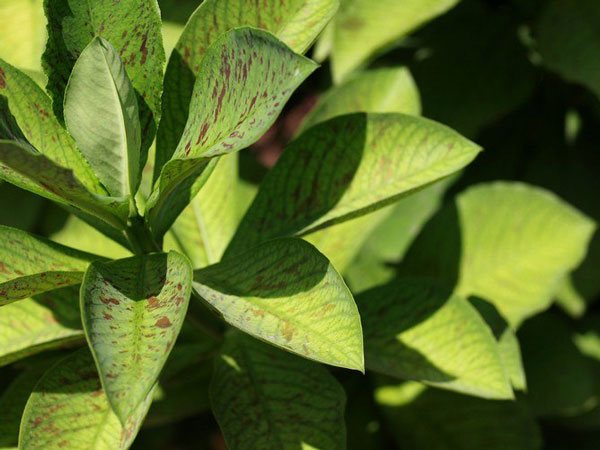

In literature and in everyday life, you can often find another name for a flower - love tree (why the plant is called so is still not known for certain).
Plant propagation
The most commonly used method of reproduction of synadenium is by cuttings left over after spring pruning, although the shoot can be cut off at any other time of the growing season, it will take root easily even in ordinary water.
The cut of the cutting is thoroughly washed under running water until the milky juice ceases to stand out. Then it is dried for several hours and buried in a peat-sand mixture. Some growers treat the rooted end of the cutting with a rooting stimulant, but many consider this procedure optional. The plant easily grows roots, and it is not at all necessary to cover the top with a glass jar or polyethylene.
New leaves that appear at the top of the cutting suggest that rooting was successful, and the young plant is transplanted into a substrate for growing adult synadeniums.
Growing a succulent from seeds is practiced much less often than cuttings. For crops, a substrate is prepared from leafy earth and sand, taken in equal parts. Sow to a depth of no more than 5-10 mm. Crops with crops are placed in a corner of the house where the air temperature is constantly maintained at not less than 18 degrees Celsius.
Seedlings germinate after 1-2 weeks. When they rise to a height of 1-1.5 cm and form 2-3 true leaves, they are dived for the first time. The second pick is made when the seedlings grow to a height of 3-3.5 cm, and they are transplanted into independent pots, already well-strengthened.
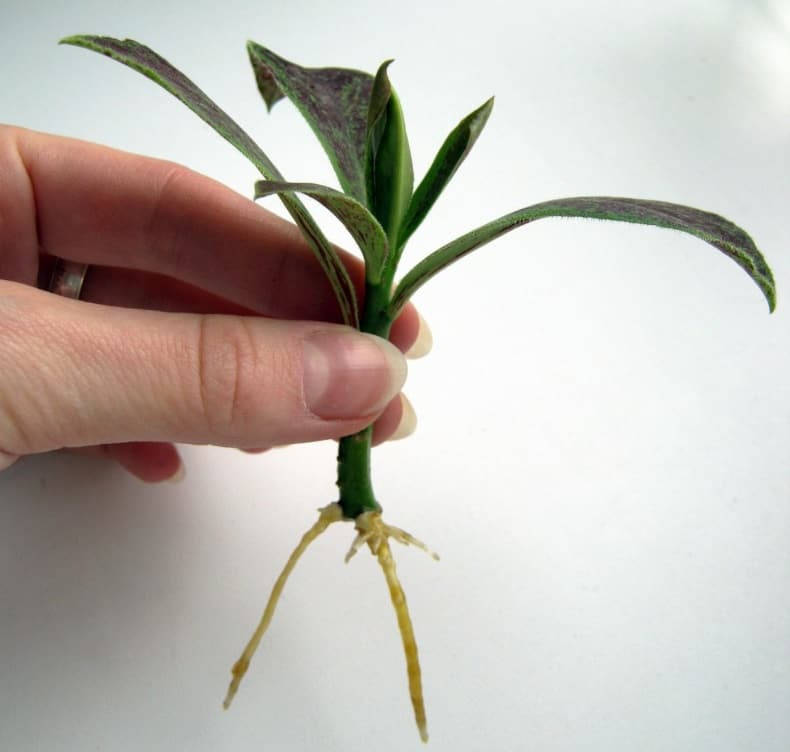

Description and popular types
Sinadenium in the wild is represented by succulent trees and shrubs with thick, erect stems and dense oval-shaped leaf plates that are attached with short petioles. The arrangement of glossy, leathery leaves is opposite or alternate.In the wild, the genus has about 20 varieties, of which only two are common in indoor floriculture:
- Synadenium Grantii- a branching shrub with numerous shoots. Thanks to the pinching, you can achieve the formation of a standard tree. The color is deep green. However, variegated varieties are sometimes found.
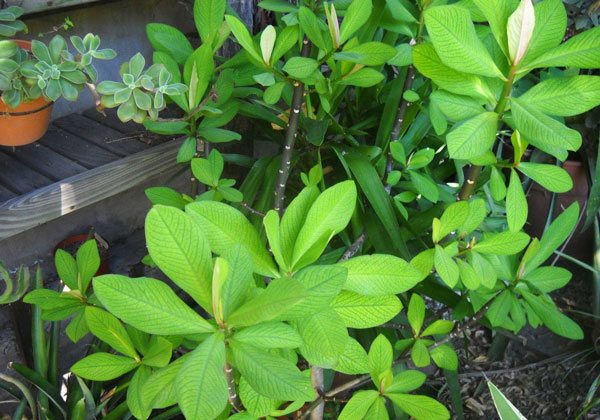

- Synadenium Rubra - a distinctive characteristic of the species are large leathery leaf plates painted with burgundy patterns of various outlines.


Description of the indoor plant of the synadenium
| Genus | Synadenium |
| Family | Euphorbiaceae |
| Homeland | Africa |
| Escape type | Straight, fleshy, smooth, dark green |
| Inflorescence | Scutellum |
| Petal color | White, pink |
| The structure and color of the leaves | Obovate or elliptical, smooth, dense Leathery, dark green |
| Flowering period | Winter |
| Fetus | Triangular box with seeds |
| Reproduction | Seeds, stem cuttings |
According to the botanical description, synadenium is an evergreen shrub native to the tropics with a wide, lush, spreading crown. In nature, it reaches up to 300 cm, while at home its height is about 100 - 150 cm. This culture is distinguished by its rapid growth. So, the plant grows 15 - 20 cm per year.
The root system is strong, highly branched, fleshy, extending deep into the soil. Shoots are straight, thick, flexible, smooth, dark green, with few lateral processes. Liquid accumulates in the shoots of synadenium, which allows it to successfully endure even prolonged drought.
Leaves are short-petiolate, opposite and alternate, obovate or elliptical, hard, leathery, rough, dark green in color. In some species, the foliage can be light green, reddish and variegated. The length of the leaf plates reaches 24 cm, the width is 11 cm.
On long peduncles, corymbose inflorescences are formed with small white or pink flowers, the petals of which are slightly bent. Outwardly, the flowers of the synadenium resemble bells. The plant blooms only in its natural environment. There is no flowering in the apartment.
The fruit is a triangular box with many seeds inside.
The photo below shows what a synadenium flower looks like, what a luxurious lush crown it has, consisting of many bright green leaves:
Features of growing a flower and creating optimal conditions
Despite the fact that the flower belongs to unpretentious indoor crops, in order to grow a healthy exotic plant in the house, you should take into account a number of its features and create growing conditions close to natural.
Requirements for the placement of the synadenium and lighting
Native of africa likes a lot of bright but soft lightwhich he can get through the windows of east or west orientation.
In the case of installing a pot with a sinadenium on the sill of the southern windows, shading should be organized at noon, when active sunlight can cause burns on the beautiful leaves of the flower.


In winter, when daylight hours are reduced, and the temperature remains at the same level, it is recommended to provide artificial lighting to prevent stretching of the plant shoots.
Temperature
During the intensive growing season of the flower, the optimal temperature regime is 22-25 ° C. With the arrival of autumn cold weather, if it is not possible to install an additional light source, it is recommended to reduce the room temperature to 15 ° C.
Humidity
A drought-resistant succulent plant perfectly adapts to dry indoor air and does not need an additional increase in the level of humidity.
As a hygienic procedure, the purpose of which is to cleanse the shoots from dust, it is carried out wiping the leaves with a damp sponge.
Soil requirements
Sinadenium is not picky about the soil composition and feels good in a loose substrate with a neutral reaction. You can make your own potting mix by combining equal parts of peat, sand and leafy soil.
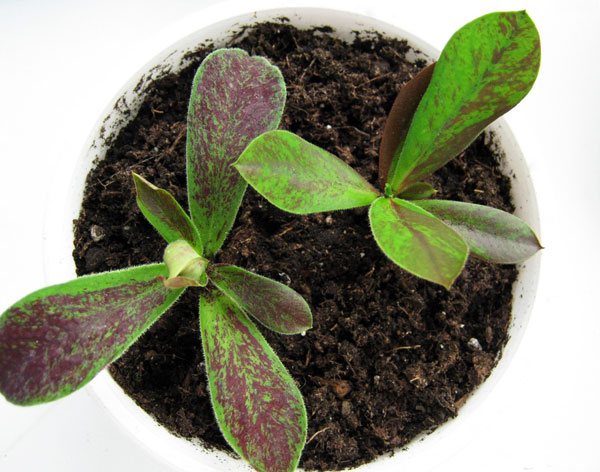

Succulent care
Sinadenium, the care of which consists in carrying out standard events, for the care and attention rendered, will delight the grower with a decorative look and excellent health.
Watering
Sinadenium, being a succulent. drought tolerant and can tolerate lack of moisture for several weeks.
But for full development it is recommended during the period of intensive growth, water the flower as the surface layer dries earthen coma. The rest of the time, it is enough to moisten the substrate twice a month.
Top dressing
Enrich the substrate with the nutrients necessary for the full development of the synadenium should be done only during the active growing season, which is in the spring-summer. Top dressing is carried out every 2 weeks using liquid mineral fertilizers for succulents or cacti.
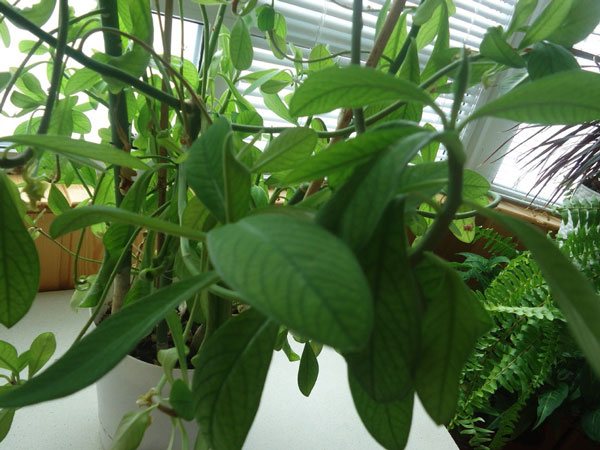

Transfer
Home care for a synadenium involves a transplant, the frequency of which depends on the age of the plant. While the synadenium is actively developing, replanting the culture will be required annually.
As they grow older, the interval increases to 3-4 years, during which only the upper layer of the depleted substrate is renewed.
The procedure is carried out at the beginning of March according to the following scheme:
- A more voluminous pot is selected.
- The bottom is lined with a drainage layer of stone chips or gravel.
- The drainage is lightly sprinkled with a substrate, onto which a flower with an old earthen lump falls.
- The resulting space is filled with a nutritious soil mixture.
Requirements for placement in the house
Lighting plays an important role in the development of the synadenium. Bright, diffused light is required to maintain the normal healthy appearance of the flower. Several hours a day of direct sunlight is allowed. The plant thrives on the southern windowsill, slightly curtained at noon, as well as on the east or west well-lit windows.
The lack of light affects the appearance - the shoots of the synadenium stretch out and turn into long, leafless sticks with a small tuft of leaves at the very top, like a palm. Although some growers like such a succulent, they deliberately try to create a plant with such a crown.
Temperature preferences in the synadenium are rather high, and for its growing season, the most suitable room temperature is 24-26 degrees Celsius. Winter maintenance allows lower thermometer readings in the room where the succulent grows, but not less than 10 degrees above zero.
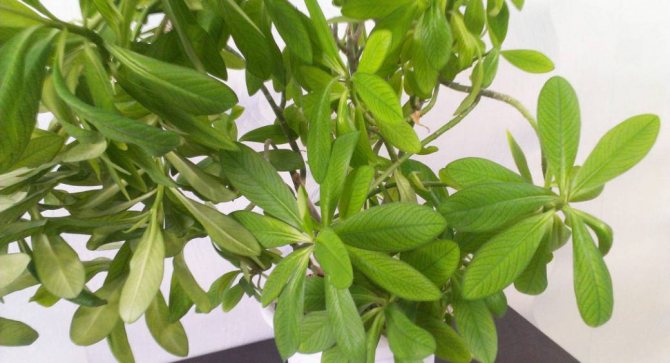

Formation of the crown of the synadenium
Formative pruning is done in early springwhen the side shoots are removed and the central trunk is pinched to form a tree.


If the plant develops in the form of a bush, then the shearing is still carried out, since it stimulates strong branching. Sanitary pruning, in which damaged, dried shoots are cut, is recommended as needed.
Growing a synadenium tree
Sinadenium Grant is the only species that is bred at home. He, first of all, will appeal to those flower growers who do not have the desire or ability to often take care of a houseplant. The tree is unpretentious to growing conditions, quite hardy, can do without watering for a long time. The only problem when growing this crop is its rapid growth, which will force you to periodically cut the shoots. Despite the unpretentiousness of the synadenium, you need to do some work when caring for it, otherwise the shrub will get sick or lose its decorative effect.
Lighting. When choosing a place for a pet, one should take into account its African origin and be guided by the fact that it is photophilous. For its development and the formation of foliage, an abundance of sunlight is necessary, otherwise the leaves will be faded.
Morning and evening direct rays will not harm this culture, while at noon they can burn the leaves, as a result of which the leaf plates begin to curl and turn yellow. That is why windows of any orientation, except for the northern ones, are suitable for its location, and if the plant is on the southern window at noon, it will have to be shaded.
If it is not possible to place a pot with a houseplant with a synadenium where it will receive a large amount of light, you will need to use artificial lighting. With a lack of light, the internodes will stretch out, and the leaves will lose their bright color.
Air temperature. This culture feels great at a temperature of 21 - 27 degrees, and it does not need a rest period. It is necessary to create such conditions for the plant to be in an abundance of light and warm.
In the cold season, you can place the flower in a cooler room with a temperature of 12-15 degrees. But at lower rates, the shrub will die. In winter, the Grant's synadenium tree requires less light and heat, but drafts and sudden changes in temperature should be avoided, from which the bush will begin to shed its foliage.
Soil and pot. The synadenium does not make high demands on the soil. The main thing is that it should be loose, nutritious, contain a drainage layer. Experienced flower growers prepare the composition for the pet on their own by mixing grain, leafy soil, coarse sand in equal amounts. Crushed coal is added to the resulting mixture to prevent root rot. Expanded clay and broken brick are suitable as drainage.
Fertilizer. An actively developing, rapidly growing plant needs additional fertilizing, which must be applied 2 times a year - in spring and summer. For this culture, a mineral complex for succulents or deciduous ornamental plants is suitable. Liquid fertilizer should be diluted in water according to the instructions and used during watering. The granules are buried in the ground, after which the soil is moistened.
Watering. This crop should be watered sparingly, as excess moisture will quickly lead to root rot. Drought, as already noted, the tropical shrub tolerates quite easily. However, if you forget about the plant for a long time and do not water it for 4 weeks or more, the leaves will fade.
When caring for a synadenium, you should adhere to a seasonal watering schedule. In the summer, it is necessary to moisten the substrate as it dries, but at least 1 time per week. In the spring and autumn, it is enough to irrigate once every 2 weeks. In winter, this work must be carried out, guided by the temperature regime in which the flower is located. In a cool room, watering is enough once a month, in a warm place 2 times a month.
It is better to use soft, chlorine-free water, therefore, before watering, it must settle, or be passed through a filter.
Air humidity. An unpretentious plant can successfully endure being in a room with dry air, but it should be kept away from heating appliances. In a prolonged drought, it is necessary to periodically (at least 2 times a week) wipe the leaves with a cloth soaked in water or spray from a spray bottle.
It is useful in the summer to bathe the plant under a shower with water at room temperature.
Transfer. Young specimens of the indoor flower of the synadenium cannot grow for a long time in one pot, since the root system braids with an earthen ball during the year and the shrub becomes cramped. Therefore, for the first 3 years, the plant is transplanted annually. Four-year-old and older individuals need a transplant once every 3 years.In tall plants, it is enough to change the topsoil.
Taking into account the peculiarities of this culture, you should choose deep massive containers for it. Wooden tubs and ceramic pots are suitable for this. Plastic dishes may not withstand and crack, or topple over under the weight of such a plant.
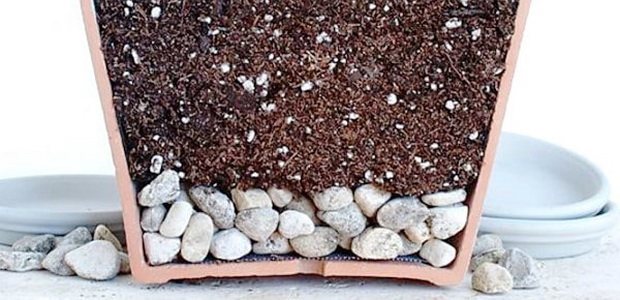

When transplanting, a drainage layer 2 - 3 cm in size is laid on the bottom of the pot. After that, the soil mixture is poured, but only by ½. The bush is removed from an old container, the roots are cleaned of the earth, some of them are removed to restrain its growth. Then the plant is placed in a new pot, filling the remaining soil, but leaving the upper part of the container 1 - 2 cm in size free.
Pruning. When breeding synadenium, it is important to know how to prune this shrub in order to slow down the intensive development of its shoots, give the crown a neat shape and keep the plant neat. Pruning should be done systematically. This work is done in early spring before the growing season. With the help of a sharp, clean knife, cut off long and bare shoots. The tops of the bush are pinched so that it branches more and is lush.
How to properly care for the Grant synadenium flower at home is shown in the following photos, where all the subtleties of this work are traced:
Protecting the synadenium from disease and pests
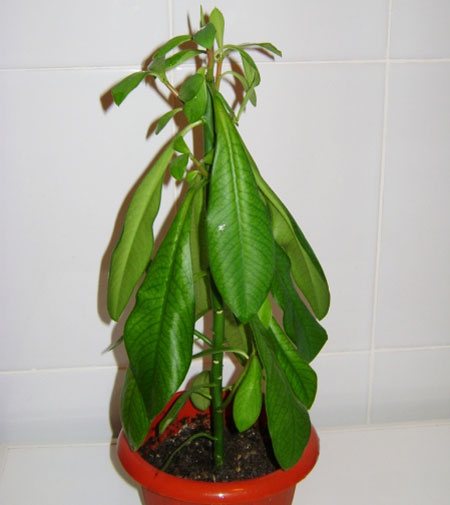

A succulent plant with poisonous sap cannot be called the favorite food of harmful insects.
However, sometimes on a weakened plant, damage to the scale insect, spider mite or mealybug can be noted, which populate indoor flowers with severe dry air.
As a protective measure, the shoots of the synadenium are sprayed with an insecticide.
With systematic overflows and low temperatures the development of gray rot can be observed, which can be cured in the early stages by transplanting the synadenium into a fresh substrate and subsequent treatment with a fungicide according to the manufacturer's instructions indicated on the package.
The main types of indoor flower synadenium
In total, there are 20 species of synadenium in the world, which grow mainly only on the hot continent. For cultivation, only one species, described below, and its variety are suitable.
Grant's Synadenium (Synadenium grantii) - a fairly common houseplant among flower growers, which is a tree with a spreading crown. This is the main type of synadenium. In nature, it forms thickets, since it branches strongly, forming many shoots that branch off to the side. If at home this culture is capable of growing up to 200 - 300 cm or more, then at home, with regular crown formation, you can get a compact bush 100 cm high.
Shoots are straight, rather voluminous, at first flexible, smooth, dark green, lignify over time, acquire a gray tint. Leaves are elliptical, dense, shiny, bright green, attached to the stem with short petioles. Located opposite. The length of the leaves of this species is 20 - 24 cm, the width varies from 10 to 13 cm.
Synadenium Rubra is a subspecies of Grant, but differs in that in its young individuals, the leaf plates have a pale pink tint. Adult plants have randomly spaced purple spots of varying sizes and shapes on the leaf surface. Due to this color of the foliage, this variety looks very decorative. In conditions suitable for a tropical plant, it can bloom. Inflorescence scutes are formed in the upper part of the shoots. The flowers are very small, bell-shaped. Flowering occurs in winter. The fruit is a triangular tricuspid capsule with miniature seeds.
The following selection of photos shows the Grant and Rubre synadenium, where you can see their differences and characteristic features:
Reproduction of the synadenium
Euphorbia synadenium propagates by seeds and vegetatively - by cuttings.
By cuttings
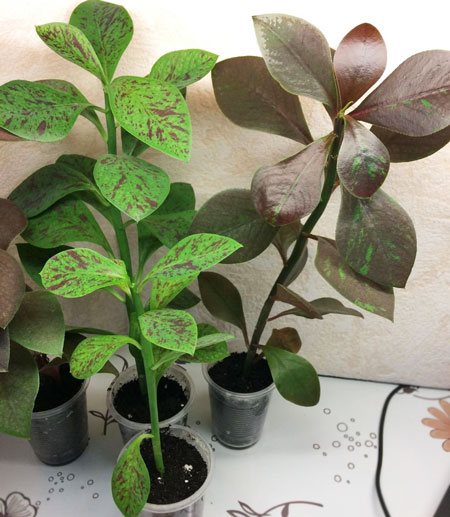

During the procedure:
Seed method
More time consuming technique, which is carried out by experienced and motivated growers. In the spring, a container for seedlings is prepared, which is filled with a sandy-peat substrate.
Seeds of synadenium are distributed over the surface of the soil mixture, after which they are sprinkled with a layer of sand of 1 cm.The crops are moistened and covered with glass. After 10-14 days of being in a bright and warm room, the first shoots appear, and the glass is removed.
When the seedlings reach a height of 10 mm, the first dive is carried out. For the subsequent procedure in permanent pots, a height of 30 mm is required.
In this video, once again, briefly about the care of the synadenium:
Synadenium transplant
Young synadeniums are transplanted quite often, every 1-2 years. Gradually, the period is increased to 4 years, and adult synadenium trees are only replaced by the top layer of soil in the tub. The pots are chosen stable and deep to prevent tipping over and to provide room for the roots. If there is a shortage of soil in cramped pots, the leaves can droop and fall off. A thick layer of coarse drainage material is poured onto the bottom. The soil should be light and fertile with neutral or weak acidity. You can make a potting mix from:
- brick chips;
- leafy land;
- river sand;
- charcoal;
- peat.
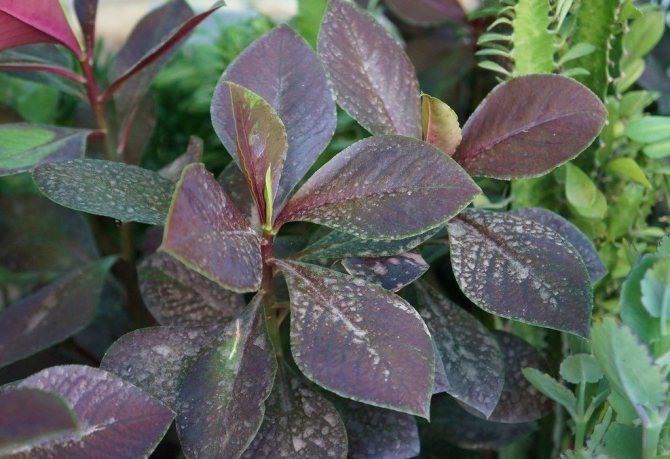

When transplanting, they try to free the roots from part of the earthy coma in order to prevent excessive acidification and depletion of the soil. You can remove some of the roots.
Signs associated with the synadenium
There are no known superstitions and signs associated with the negative impact of the synadenium on the inhabitants of the house where it is contained in the literature. But among people there is an opinion that it is not worth keeping a flower in the bedroom, which is explained by its poisonous juice.


Thus, the representative of the tropical flora, the synadenium, is a spectacular plant that can decorate the home of even inexperienced gardeners who want to plant greenery.
Syngonium - signs and superstitions
Like most indoor plants, the syngonium has overgrown with a considerable number of signs and superstitions that consider the flower both from a positive and a negative side.
Signs about syngonium
If indoor plants could choose their profession, then the syngonium would certainly become a forecaster. The fact is that this green pet is able to predict the approach of rain. Before precipitation, the syngonium begins to “cry”: water droplets form on the pointed tips of its leaves.
A similar phenomenon, characteristic of this vine, can be quite logically explained from the point of view of science. Originating from thickets of tropical forests, syngonium has a special love for moisture, and droplets of water on the tips of leaves are its natural reaction to high humidity, which often precedes rain.
Positive superstitions about syngonium
Popular superstitions have not bypassed the syngonium either - they are associated with the energy of this indoor plant.
Superstitions attributing to the syngonium a beneficial effect on a person and the atmosphere of his home:
- Syngonium is a flower that guards family happiness.
- Just as a plant itself changes and transforms over time, so it changes the people around it:
gives birth to in their minds
craving for changes in life.
For this reason, syngonium is recommended to be grown at home by inveterate conservatives, suspicious of everything new, not happy with the modern world. Liana will smooth out their difficult temper, instill loyalty and tolerance. - If a person is not a conservative to the core, but dreams say goodbye to the past
, which pulls him back and does not allow him to breathe deeply, he is simply obliged to start a syngonium. An indoor flower will speed up this separation, make it more painless. - Syngonium consider a symbol of positive change,
therefore it is believed that liana
accelerates the patient's recovery.
If various diseases are frequent guests in the family, be sure to allocate space in the house for this plant. - According to another belief, the syngonium has the ability to eliminate bad dreams and nightmares
... Therefore, people suffering from these nocturnal phenomena should settle this green comrade in their bedroom. - Another belief says that the syngonium is successful fights against any complexes and helps to establish contacts with others.
In this regard, it is recommended to keep the vine at home for people suffering from self-doubt and those who find it difficult to communicate with other representatives of society. - Syngonium also will help you quickly learn new knowledge and adapt to a new environment.
To this end, newly-made students can begin to grow it at home, especially since caring for this indoor flower will require a minimum of effort from the owners.
Negative superstitions about the syngonium
Many amateur flower growers would be happy to replenish their home collection of flowers with syngonium, but they are stopped by the negative superstitions associated with this vine. Let's consider the most common of them.
Syngonium is muzhegon
- a flower that drives men out of the family and from the house. However, almost all indoor plants growing in the form of vines (ivy, hoya, scindapsus and others) have won the same fame.
However, an analysis of all kinds of floricultural forums refutes this superstition: young ladies and ladies write that representatives of the strong half of humanity get along well with the syngonium and are in no hurry to leave home anywhere. Therefore, we can say that this belief is not true at all, but an ordinary prejudice that has no foundation whatsoever.
Another superstition invented by adherents of the Chinese teachings of feng shui says that syngonium is "poisonous breath"
.
According to feng shui, "poisonous breath", poisoning people and negatively affecting their lives, highlight all the sharp corners that are in the home. Houseplants with arrow-shaped leaves have the same property. It is logical to assume that the syngonium received the fame of "poisonous breath" precisely because of its arrow-like leaves. If this fact scares you, do not rush to get rid of the plant, but follow the advice of the feng shui masters: place protective amulets next to the syngonium that can neutralize negative energy.
If you look at the second superstition from a scientific point of view, you can explain it by the presence of poisonous milky juice in syngonium (a characteristic feature of all Aroids), which can irritate the skin or lead to poisoning if ingested. Therefore, for safety reasons, any manipulation of this vine is best done with gloves and keep it away from children and pets.
Plant varieties
Sinadenium is a flower that has more than 20 varieties, but only a few of them are considered indoor plants that take root at home. It is also called the euphorbia sinadenium, since when the stem is cut, the plant begins to secrete a milky liquid. You must be extremely careful with it, because it is poisonous.
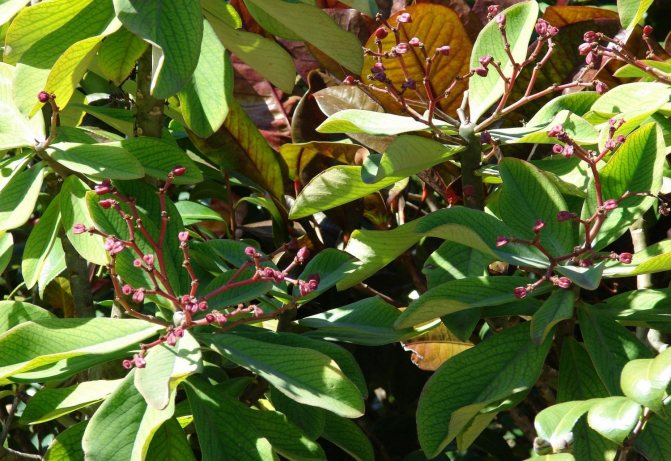

Synadenium Grant
For your information! Often the synadenium plant appears as a tree of love, why is it called that? It is believed that this is due to its unusual flowering, flower shape and its interesting color.
Synadenium Grant
The plant can be up to 3 m in height, has oval-shaped leaves, which are attached with roots to the stem. The leaves of Grant's synadenium are very hard and shiny, the length of one leaf can reach 25 cm, and the width is 12 cm.
Synadenium Rubra
This plant has already been bred from Grant's synadenium. Sinadenium Rubra differs from its predecessor in that there are burgundy spots on its leaves, and their shape is uneven. The plant blooms at home in the middle of winter, it throws out long peduncles from the very top.
Note! There is a completely burgundy synadenium, as well as with red, yellow and glossy leaves.


Synadenium Rubra
Plant toxicity
Sinadenium, despite its outward beauty, is highly toxic. Its leaves and stems contain juice, which is dangerous to humans.
Important! When the milky substance gets on the skin of the hands, a severe burn appears, and on the mucous membrane, severe poisoning.
Also, the plant is of great benefit, since it is possible to prepare a tincture from it, which will help to cope with diseases of the stomach, bladder and headache.
Grant's synadenium is a very beautiful and fast-growing plant that can be easily propagated and created at home a whole greenhouse, but nevertheless, care must be taken when working with it, as it is poisonous and can be harmful to health.
What pests and problems can you face?
Sinadenium is considered a hardy plant. Not susceptible to attacks by pests. Sometimes it is affected by common pests of indoor flowers. Most often, flower growers have to deal with a mealybug. Less often - a spider mite, whitefly. According to some reports, a scale insect can settle on the synadenium. According to observations, the scale insect does not move to the synadenium even with close contact with an infected flower. More often, problems arise due to gross errors of care.
| Shedding leaves | It is connected with a sharp change in the conditions of detention. Loss of leaves occurs due to a sharp change in temperature, an acute shortage or excess of moisture, after transplanting or watering with cold water. With the loss of a large number of leaves, root rot is not excluded. | The decorativeness of the plant is restored by pruning and adjusting the conditions of detention. The flower quickly grows over with new shoots. When decaying, the damaged roots are cut off, sprinkled with coal powder, transplanted into fresh soil. |
| Leaves are falling | Sign of lack of moisture in the soil. | After watering, the turgor is quickly restored. |
| Pulling the stems | Acute lack of light. | To restore decorativeness, pruning is carried out. The intensity of pruning depends on the condition of the plant. |
Sinadenium is a great option for those who love large plants, but do not have enough time to care for them. Unpretentiousness, decorativeness, resistance to pests and negative factors are features that are especially appreciated by flower growers.
Description
Representatives of the genus Sinadenium (Synadenium) are naturally found in South and East Africa. This genus includes about 20 species of evergreen shrubs and trees. The genus belongs to the family Euphorbiaceae or Euphorbiaceae.
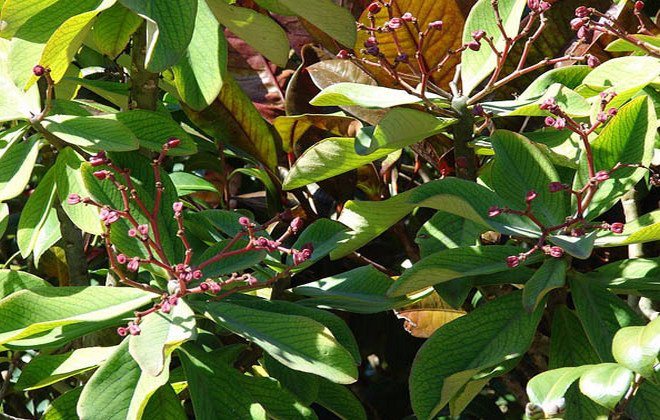

The plant is distinguished by straight, thick stems and fleshy ovoid leaves. Blooms in summer. The flowers are small, red, and form inflorescences. Two species are grown as indoor plants - Grant's synadenium with green leaves and Rubra's synadenium with burgundy leaves.
Exotic indoor plants also include pandanus, strelitzia, alocasia, pachypodium, hymenokallis, drymiopsis, cicas, Forster's hoveia.
The second name of this plant is the tree of love. The origin of this name is unclear.
Did you know? The type of synadenium Grant (Synadenium grantii) is named after the British explorer of East Africa, James Augustus Grant, who described it in 1875.
The tree of love grows very quickly (up to 25 cm per year) and can reach one and a half meters in height. Refers to succulent plants, i.e. accumulates water in its fleshy stems. Usually, indoor synadenium is in the form of a shrub, but by pruning, you can form a tree from it.
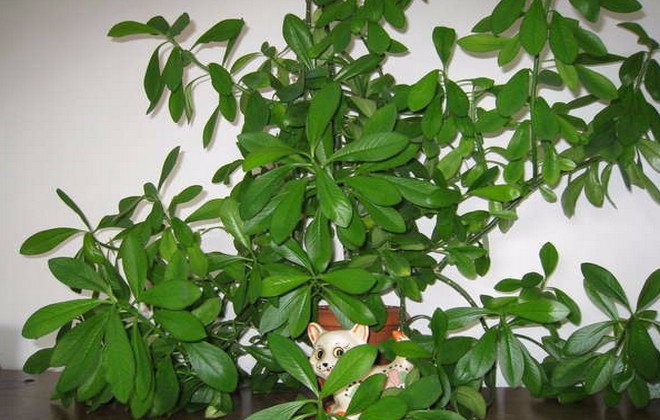

How to care for a plant
It is difficult to regulate the height of the plant, but caring for the synadenium at home is very simple.
Lighting
Streams of light should be scattered, bright direct rays have a detrimental effect on foliage, as well as a sharp increase in daytime. The leaves react to these factors with yellowness, brown spots and even curl.
Therefore, the plant can be placed in more shaded areas of the room. In the shade, the bush lets out strong juicy leaves of a rich green color.
Temperature
In the summer it should be warm, from 23 to 26 is the best degree interval. In winter, you can keep the flower cool, but this is not necessary, as is the case with some succulents. This plant does not need rest.
With a sharp cold snap or drafts, the evergreen plant begins to shed its leaves.
The maintenance conditions must be changed depending on the ambient temperature. When it is too hot, it is necessary to increase the flow of light to the plant and the amount of watering; at temperatures below average, everything is done the other way around.
Earlier we talked about the houseplant euphorbia.
Watering
It is necessary to water it with non-chlorinated water, not too often, so that the top layer of the earth dries up to 2 centimeters. The plant is used to slight droughts. Water should moisten the soil evenly, holes are required at the bottom of the pot for water outflow. Do not allow moisture to accumulate.
Sometimes it is recommended to rinse the dust off the leaves with a warm shower.
Top dressing and pruning
The plant grows quickly, especially in spring and summer, so it needs feeding 3 times a month. Fertilizer should be diluted with plenty of water and used as irrigation. As a supplementary food, mixes for cacti are suitable.
You need to know how to cut a synadenium, because you will constantly have to form the growth and crown of the synadenium flower. This procedure must be done with caution, since the juice of the synadenium is poisonous.
The poisonous flower synadenium is not afraid of parasites and diseases are not afraid of it. Root decay can occur with improper watering for a long time.
general characteristics
Sinadenium is a fairly massive tree, in nature capable of reaching a height of up to 3 m.Differs in rapid growth and development - the annual growth is 20-25 cm.
Refers to the number of succulents. The root system is branched, extending deep into the soil.
On the branches, rare erect processes are formed, which are characterized by a thickened structure, which allows the plant to adapt to adverse conditions during a drought. The surface is covered with a smooth rich green skin.
Leaves are dense, leathery, attached to short petioles. The shape is oval or obovate. They are located opposite or alternately.
Planting and transplanting
In order to avoid stagnation of water, it needs good drainage, which is organized from expanded clay mixture, broken brick.
A suitable pot container is deep and stable, made of clay or expanded clay, the porous walls of which are capable of allowing air and moisture to pass through.
Landing technology:
- the bottom is laid out with drainage;
- the pot is filled with the substrate by ½;
- the flower is set in the central part, the roots are straightened and sprinkled with earth mixture.
The soil mixture can be made independently by combining peat, leafy soil and coarse river sand.


It is better to do a transplant in the spring.
The regularity of the transplant depends on the age of the flower culture:
- a young plant is transplanted almost every year;
- from 4-5 years old, the pot is replaced every three years;
- they try not to change the growth conditions for the old succulent, they manage by replacing the surface layer of the substrate by 4-5 cm.
A suitable time for transplanting is the beginning of spring, more often March. The preferred method is transshipment while preserving the earthen clod.
Reproduction, transplantation, treatment
Sinadenium Granta is characterized by resistance to external conditions of habitation, is distinguished by high decorative qualities, unpretentiousness and intensity of growth. The plant is transplanted every 2-3 years, usually in the spring.
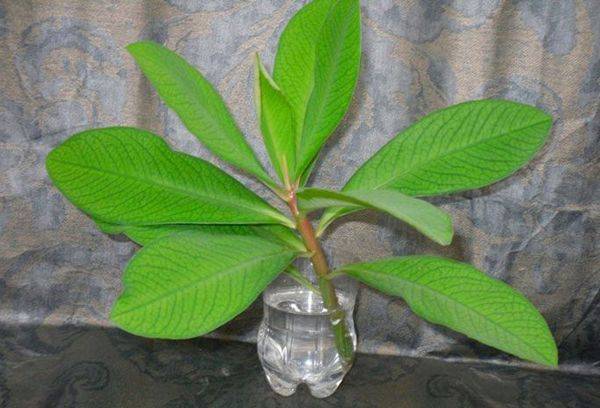

For flower propagation, stem cuttings are used, which are placed in water to grow roots, and then planted in a suitable soil. For better rooting, the cutting is kept for some time in greenhouse conditions - under a transparent cover.
Important All work with the flower should be carried out with gloves, as its milky juice is poisonous. Getting on the mucous membranes, it leads to their irritation and inflammation. Causes poisoning if swallowed. If animals and milkweed live in the same territory, you should be more careful.
Milky sap naturally protects the plant from pests, as it is toxic. When growing synadenium, flower growers are often faced not with parasites, but with yellowing and wilting of foliage. The reason for this is the too cold and dry indoor climate. Excess moisture leads to darkening and twisting of the leaf plate, which means the loss of the decorative qualities of the flower. Leaves fall even if the living conditions and the nature of the lighting have changed.
The rarely ailing and outwardly beautiful synadenium flower is called the “tree of love”. He gratefully responds to the care and attention from the person. They can decorate the window sill in the apartment and in the country, in the house and in the office. The only difficulty in growing this plant is to create favorable conditions around it - permissible humidity and optimal illumination.
Description of culture
The Sinadenium Granta flower is a branched shrub with many erect, voluminous shoots. It differs in:
- large size - more than 3 meters in height (at home up to 1.5 meters);
- rapid growth - up to ¼ in growth per year;
- a powerful root system.
The branches of the plant are covered with oval foliage on short cuttings. The shiny leaves have a dark green hue, they grow up to 25 cm in length, and reach 12 cm in width.
In natural habitat, the culture blooms in winter. At this time, umbrella inflorescences appear. They consist of small red bell-shaped flowers. After flowering, three-lobed fruits with burgundy seeds are formed. At home, the plant rarely blooms.
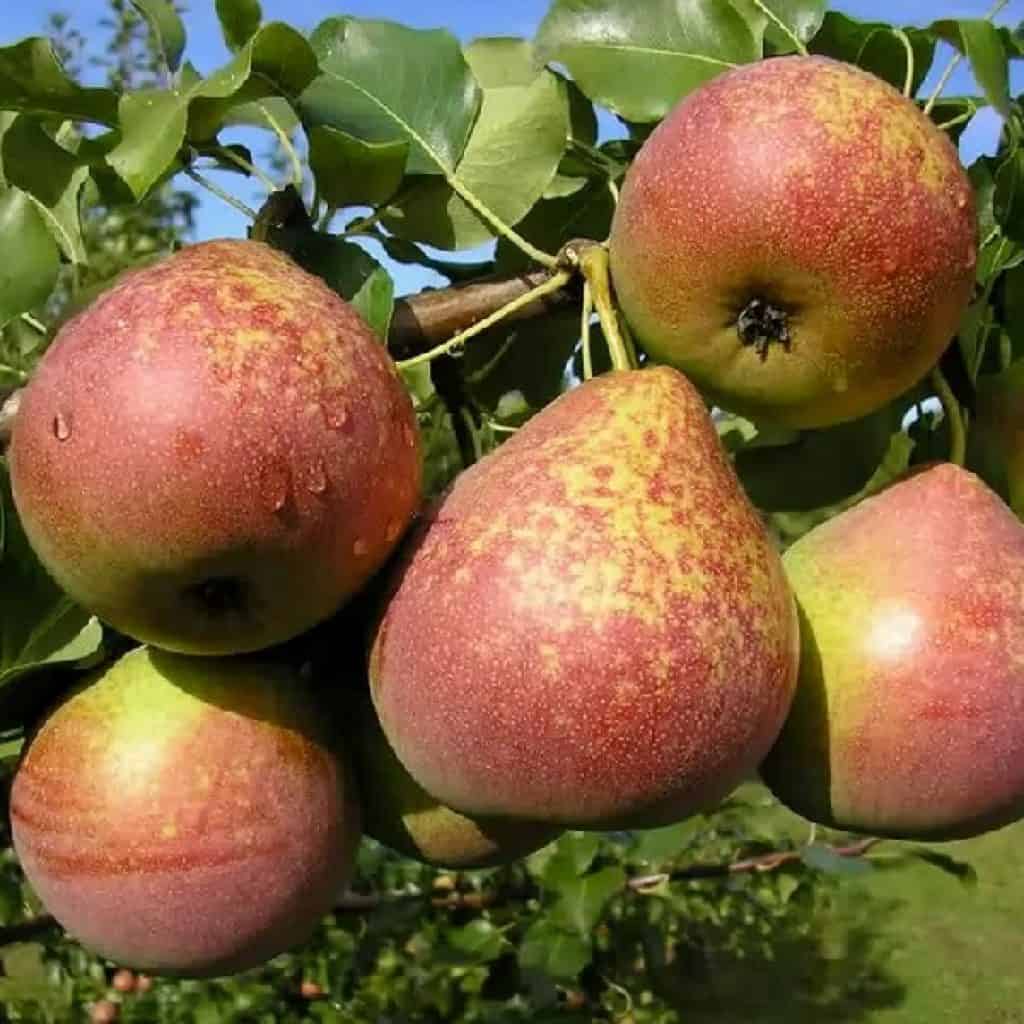

Grant's Synadenium is a highly toxic plant. When his milky juice enters the stomach, severe poisoning develops, up to and including death. If it gets on the skin, irritation and an allergic reaction appear.
To avoid health problems, use rubberized gloves when handling the crop. It is not recommended to keep it in rooms with small children and animals!
The necessary conditions
Suitable location and ground requirements
Requires a lot of light (diffuse).
Sinadenium can grow in any direction, but east and west are best.
When placed in the south, it needs shading to avoid burning the foliage, in the north - in supplementary lighting.
For planting a home plant, a soil mixture designed for growing succulents is suitable.
Charcoal and brick or expanded clay chips are added to the soil for indoor plants. The first component serves as an antibacterial agent for the prevention of root rot, the second acts as a baking powder and improves the drainage properties and aeration of the substrate.
Temperature
It needs to maintain a constant temperature in the range of 20-26 ° С, because the resting phase in him is practically absent or weakly expressed.
The maximum temperature is 30 ° C, the minimum is 10 ° C.
- Sharp drops, combined with drafts, drops cause the leaf mass to fall off.
Humidity
A succulent plant is able to easily carry dry air, incl. when using heating devices in winter. The optimal performance is 50%.
Showers are additionally carried out in summer.
Spraying is not recommended. They are replaced by wiping the leaves with a damp cloth to remove accumulated dust and improve photosynthesis.
Lighting
In low light conditions, it is necessary to use artificial lighting to prevent stretching of internodes and loss of decorative leaves, especially in winter.
The optimal daylight hours are 8 or more hours.
Growing and care
Despite all the difficulties, euphorbia is very attractive to flower breeders. Caring for it includes watering, regular pruning, replanting every two years, and reproduction. This plant is practically not susceptible to diseases and is considered quite resistant to various pests. For the rest, caring for him should be like this:
The benefits of the berries of the black nightshade plant
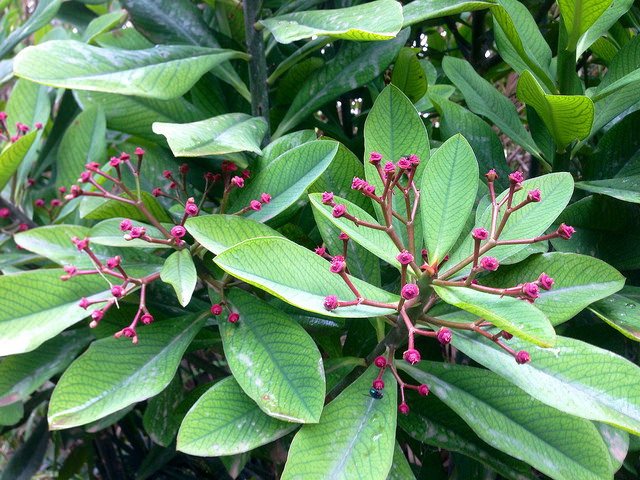

Temperature and light
This tropical flower loves ambient light and does not tolerate shade.... If there is poor lighting, the peduncles will begin to stretch, and the bush will deform. In winter, be sure to provide additional lighting to increase daylight hours. In summer, the synadenium is often taken out onto a balcony or loggia. Comfortable temperature for milkweed is 22-27 degrees in summer and not lower than 12 degrees in winter. This flower prefers to grow on the west and southwest side of the house.
Humidity and watering
Sinadenium does not tolerate waterlogging. Watering should be moderate and infrequent. It perfectly tolerates dry winter air in the apartment and does not require leaf wetness. Water it, as a rule, only after at least two centimeters of the top layer of the earth has dried. A lack of moisture often leads to dried leaves, and an excess of it leads to rotting of the roots.
Pruning and replanting
This flower is actively growing and therefore constantly needs pruning. A young plant must be pinched to form a bush. Otherwise, the synadenium will begin to grow in height. During work, it is imperative to maintain safety measures and use gloves.
The flower is transplanted every two years. Its root system is quite spreading, so the pot should be deep and free. In too cramped pots, the plant feels uncomfortable and begins to throw off the leaves. When replanting, a soil mixture is used, which consists of the following components:
- Three pieces of parkland.
- One piece of coal.
- Two pieces of peat.
- One piece of sand.
- A crumb of brick.
Sinadenium prefers light, slightly acidic soil with ample fertilization.
Top dressing is applied during watering. As a rule, a fertilizer intended for cacti is used. And you can also use popular mineral fertilizers - Ammophos and ammonium sulfate.
Woolly cleaver: description, care, cultivation, planting
Flower propagation
This plant propagates by seeds and cuttings.... The top of the stem, 10 to 15 centimeters long, is used as cuttings. Each cutting must have at least 4 leaves. The stalk is dried for 24 hours. The cut must be sprinkled with coal. For rooting the cuttings, the following soil mixture is prepared: peat, park land and river sand are taken in equal shares. It is poured into a small pot and the cutting is deepened by 2 cm. After 20 days, the plant will be ready for transplanting to a permanent location.
The seed-assisted breeding method is more complex and time consuming.In early spring, they are sown in the soil, which consists of park land and sand. From above, the seeds are covered with foil to create a greenhouse effect. Every day, the film is thrown back and the soil is moistened with a spray bottle. The first pick is carried out when the sprouts reach two centimeters in height.
Purchase rules and adaptation period
The best time to shop is spring. During the spring-summer period, the houseplant will have time to adapt to the new growing conditions to strengthen and build up the vegetative mass before the resting phase.
The average price is 500 rubles.
When purchasing a synadenium, you should pay attention to its appearance. A healthy flower culture:
- bright saturated color of leaves without spotting and signs of pests;
- intact root system.
The first 2 weeks of a newly purchased plant are given time to adapt, they are not transplanted or fed. Subsequently, care is provided in accordance with the basic rules.
Possible difficulties
From excessive watering, the base of the plant trunk can begin to rot, and from a lack of water, the trunk wrinkles, the leaves droop and fall off. With a lack of lighting in combination with a warm room, the shoots stretch out and the appearance of the synadenium deteriorates.
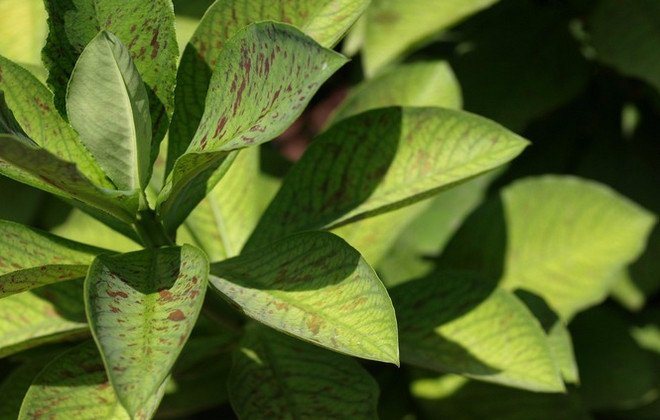

To return the plant to its previous spectacular appearance, you need to cut off such shoots.
The leaves of the tree of love can also fall off when the external conditions change too abruptly - with jumps in air temperature, the use of cold water for irrigation, a sharp change in illumination. Normalization of conditions, maintenance and pruning of shoots will quickly return the previous appearance to the synadenium.
Brief conclusions
- Grant's Synadenium is a fast-growing succulent plant. In the wild, it grows in the tropics and subtropics of South Africa, reaching a size of over 3 meters.
- The flower, unpretentious to growing conditions, is poisonous, its milky juice is dangerous to health. All work on caring for him must be carried out in rubberized gloves. Keeping a culture where there are animals and small children is not recommended.
- For propagation of plants, use the method of cuttings or sowing seeds. The second method is laborious and therefore rarely used.
- After planting, the flower needs good care for active growth and development. He needs a lot of diffused light and high air temperature, moderate watering and high-quality feeding. Formative pruning should be done to contain the growth of the succulent.
- The plant needs to be repotted periodically. The regularity of the procedure depends on its age, if young specimens are transplanted annually, then with age every 3 years, simply changing the topsoil. By the way, there are few requirements for it, the main thing is looseness and neutral acidity. In such conditions, the plant will actively grow, and may even please with flowering, which is a rare pleasure to observe at home.
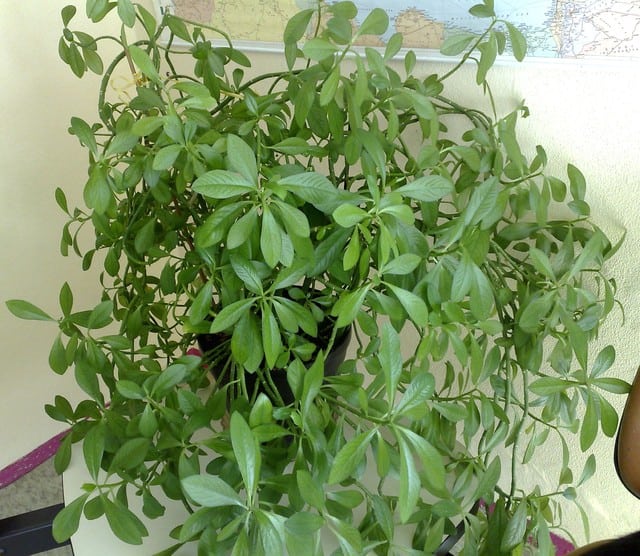

Landing rules
When the culture becomes cramped in the pot, this is clear from the external characteristics - the leaves wither and fall off.
A stable planter with drainage holes at the bottom is chosen as a new container.
Stages:
- A thick drainage layer is laid on the bottom of the container.
- Pour out half of the substrate.
- The plant is removed from the old pot, the partially earthen lump is carefully removed. Then they are placed in a prepared container and poured with soil so that about 1 cm remains from the edge.If necessary, to restrain growth, part of the roots is cut off.
All manipulations are carried out in protective gloves - the succulent secretes toxic milky juice, which causes severe irritation of the skin and mucous membranes.
Reproduction methods
There are two ways to propagate a plant: seeds and cuttings.
- The first method has some complications. Sowing is carried out only in spring in a mixture of sand and soil. Before the appearance of sunrises, the dishes must be kept at a temperature of about 18 degrees.The rest of the instructions should be read on the seed packet before the procedure.
- The second method allows you to propagate the plant in March or April. At the top of the stem, a shoot with three internodes is selected, pruned and placed in warm water to stop the milky juice. Next, a dried cutting is planted in a mixture of sand and peat, covered with a transparent cap and waiting for rooting.


Temperature and lighting when caring for a flower
Caring for Grant's synadenium is almost the same as for other succulents of the Euphorbia family.
The plant thrives in diffused light both in winter and in summer. In insufficient light, the flower begins to stretch and loses its appearance. Therefore, in winter, you need to provide him with additional lighting. If for some reason it is impossible to do this, then it is advisable to lower the temperature in order to temporarily stop the growth of the plant.


In the summer, a glazed ventilated balcony will suit the flower - there it will be as comfortable as possible. The optimum temperature for Grant's synadenium is 23-26 degrees. The plant tolerates hot summer weather well and adapts to coolness (up to +10 degrees). The temperature should not drop below, as this can affect the plant (high risk of root death).


